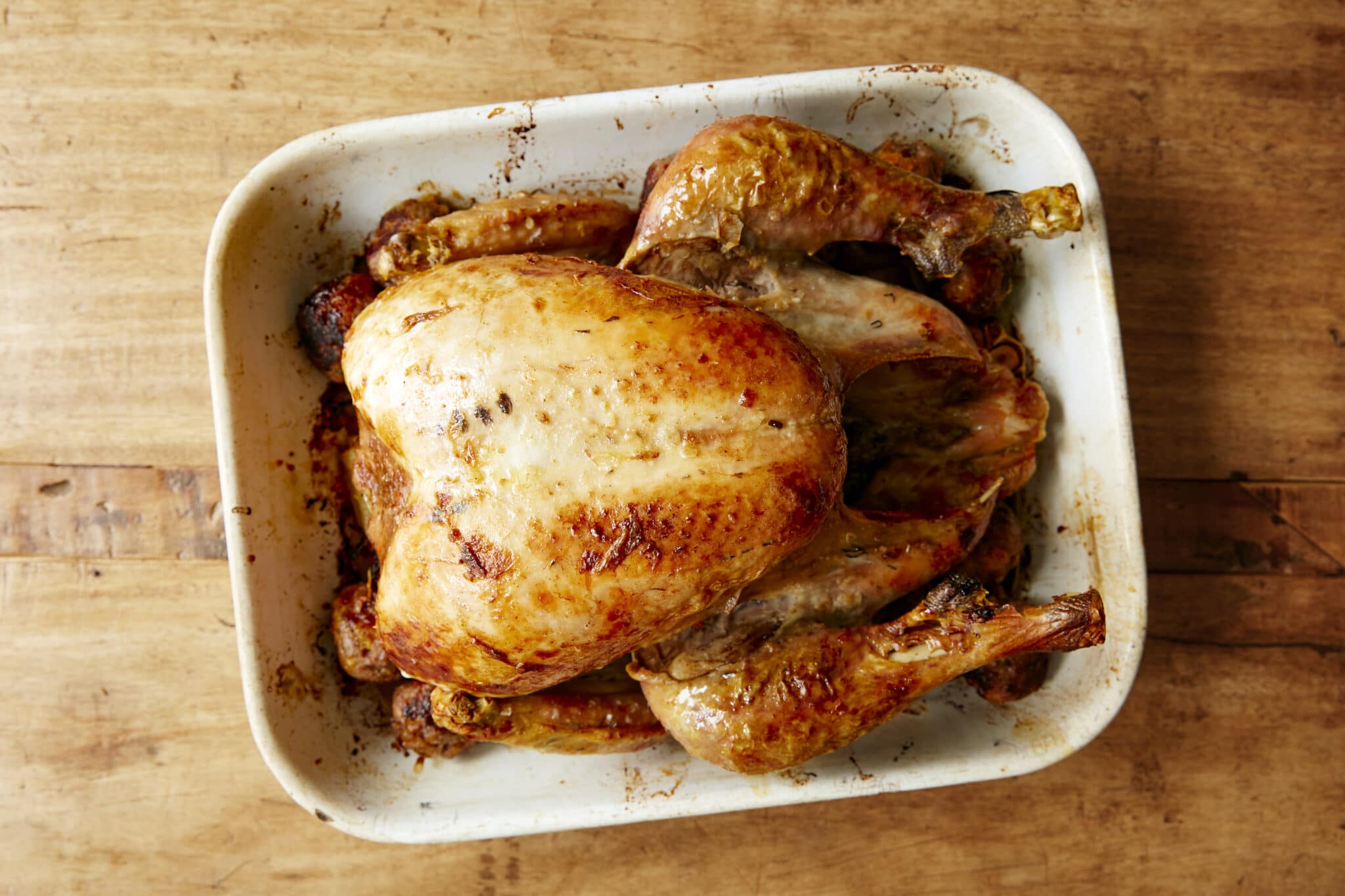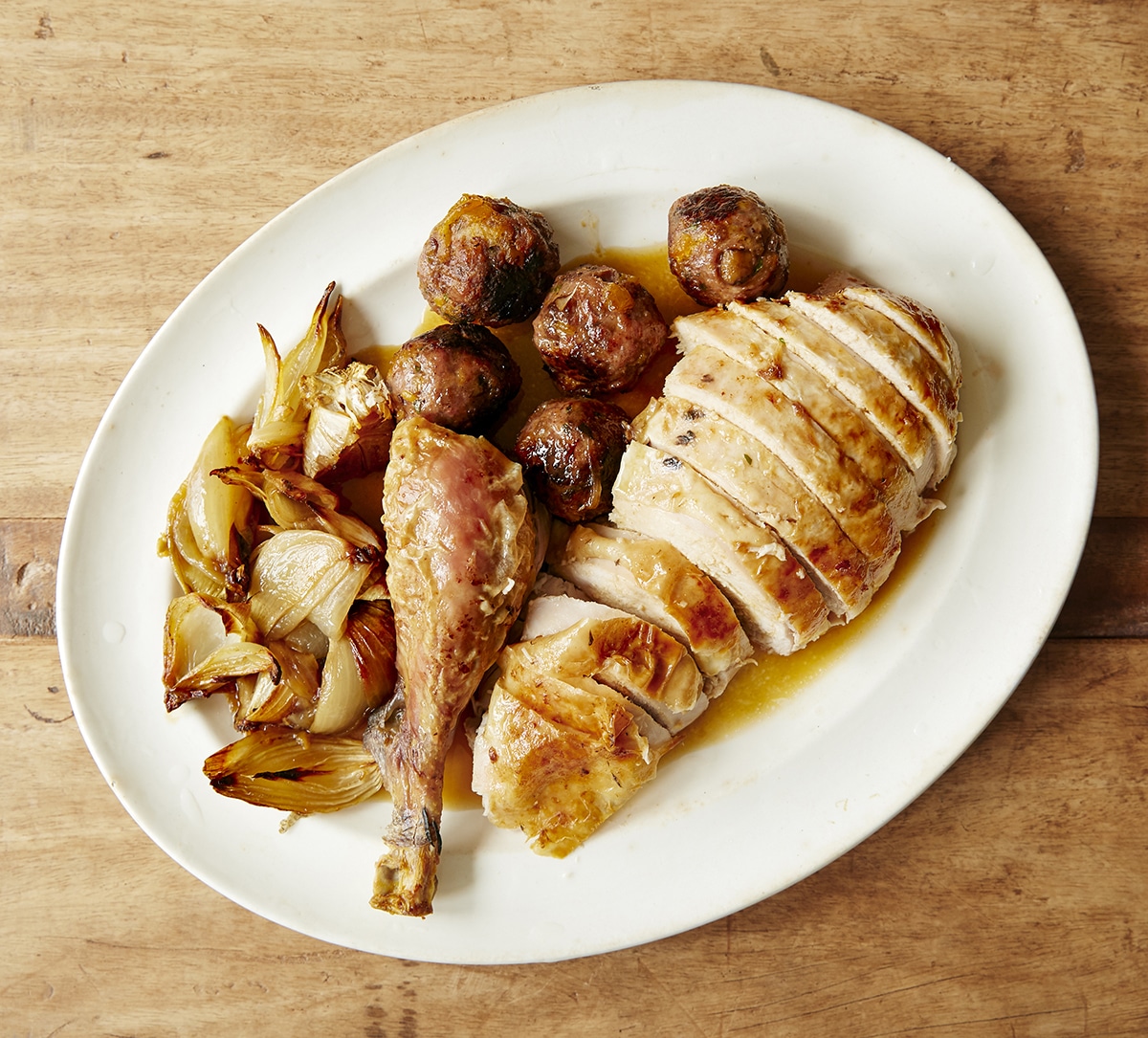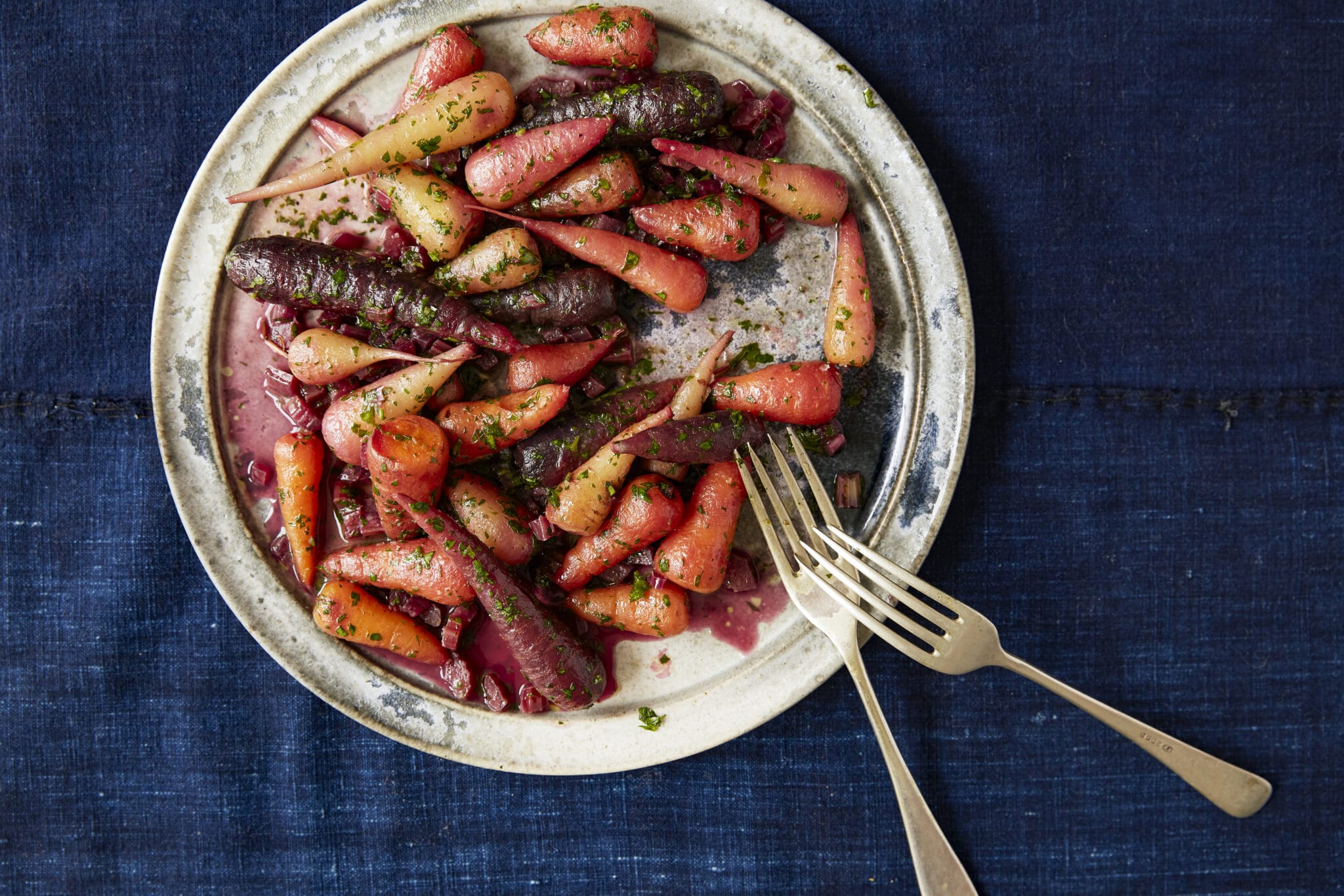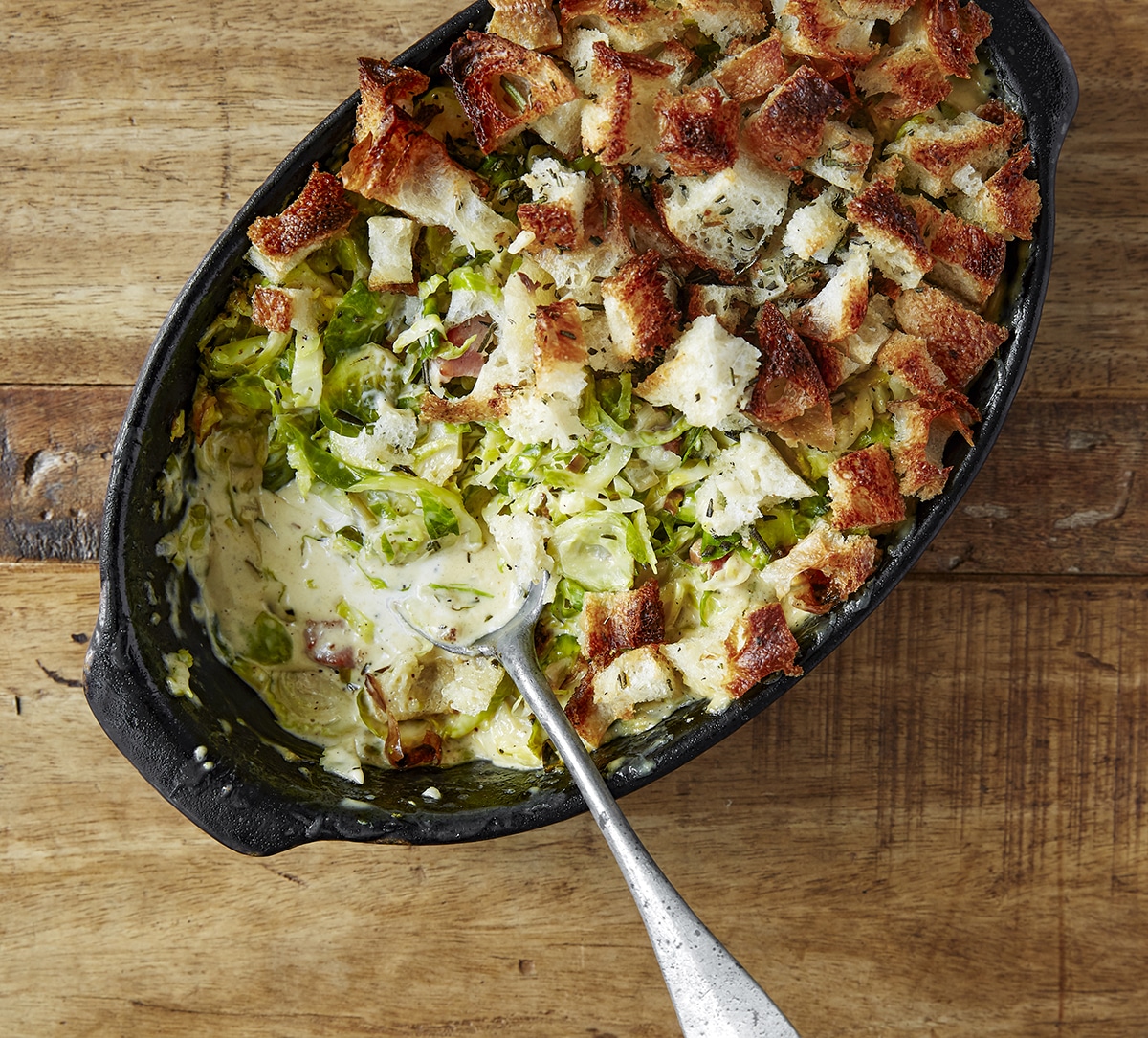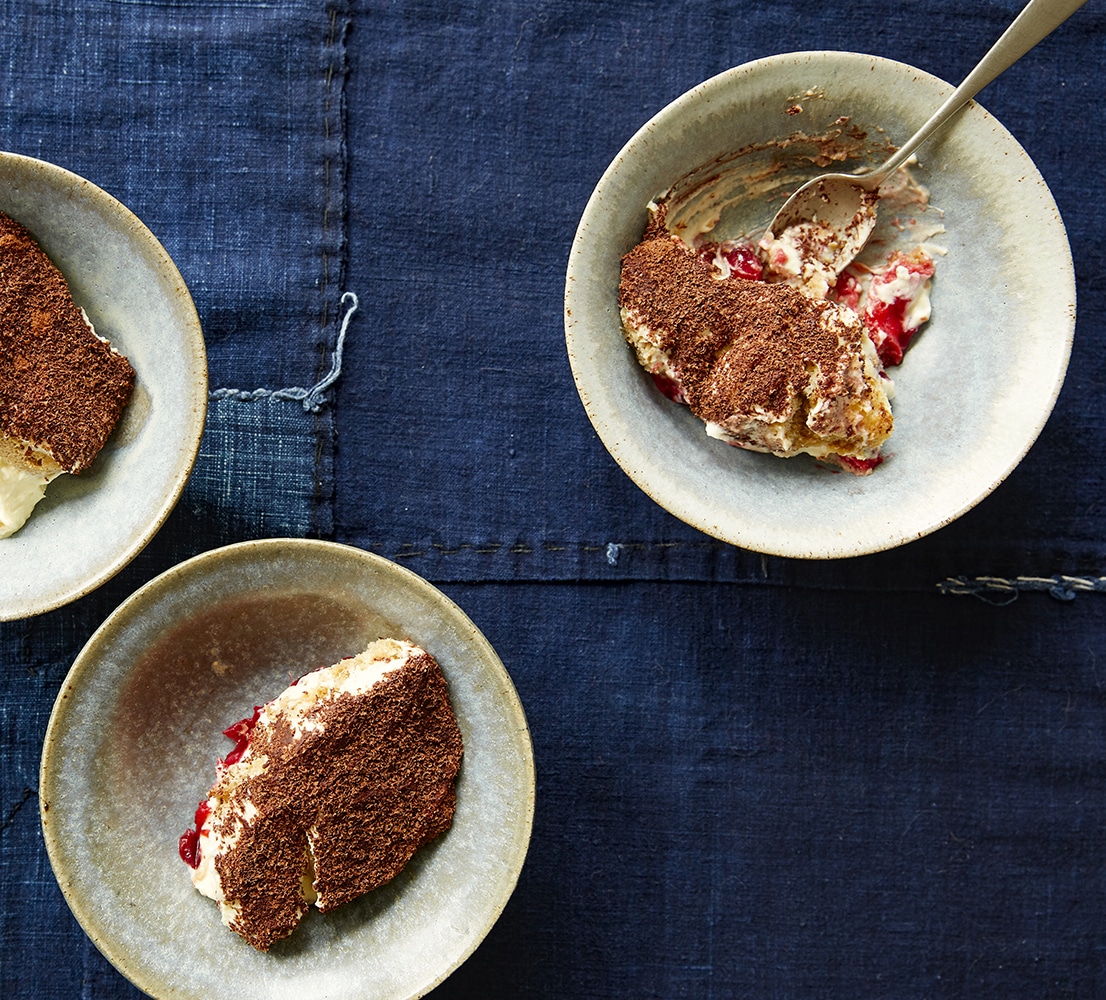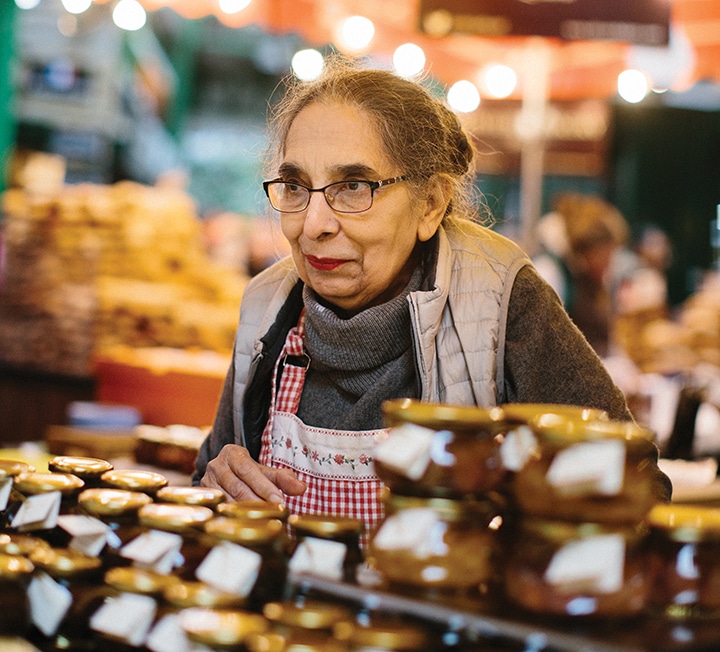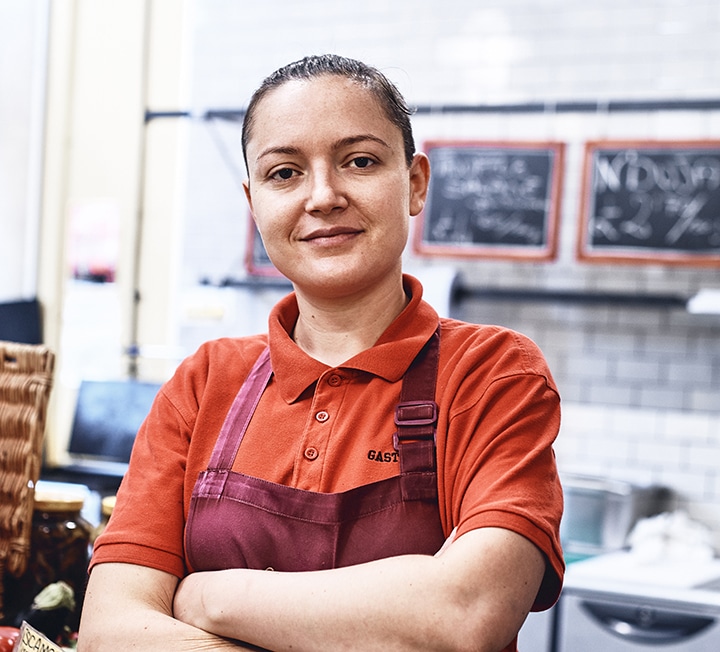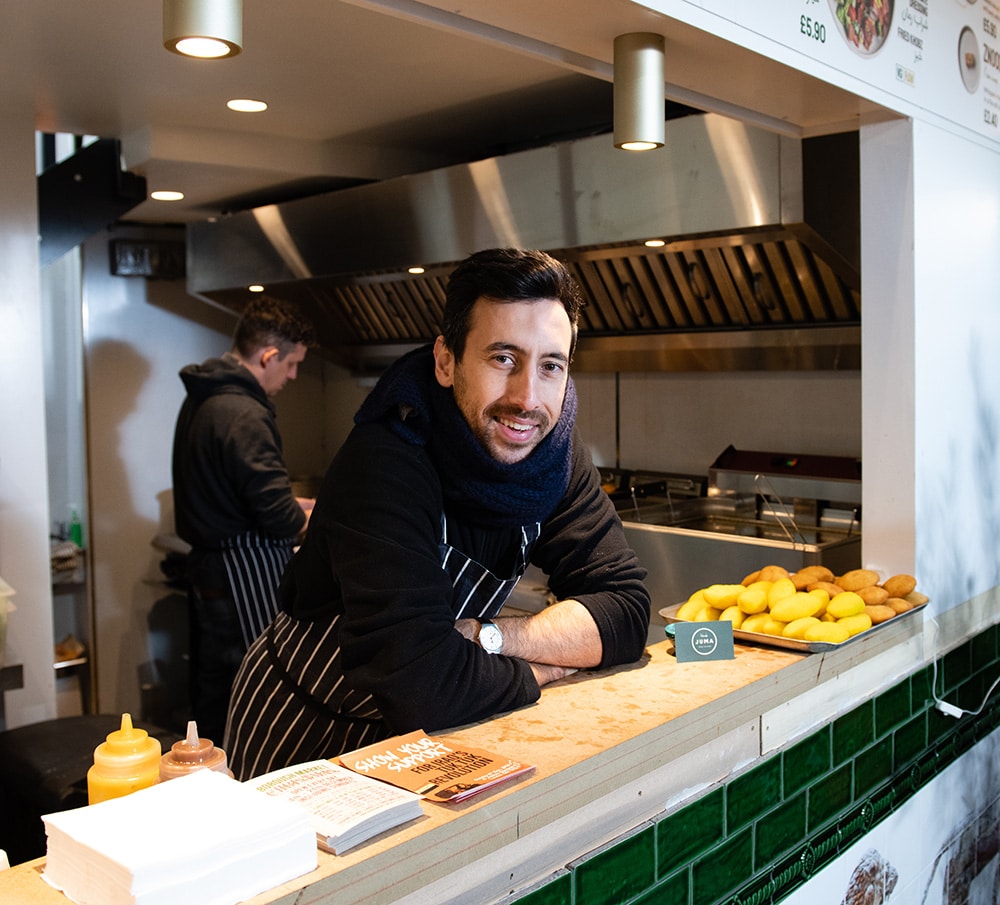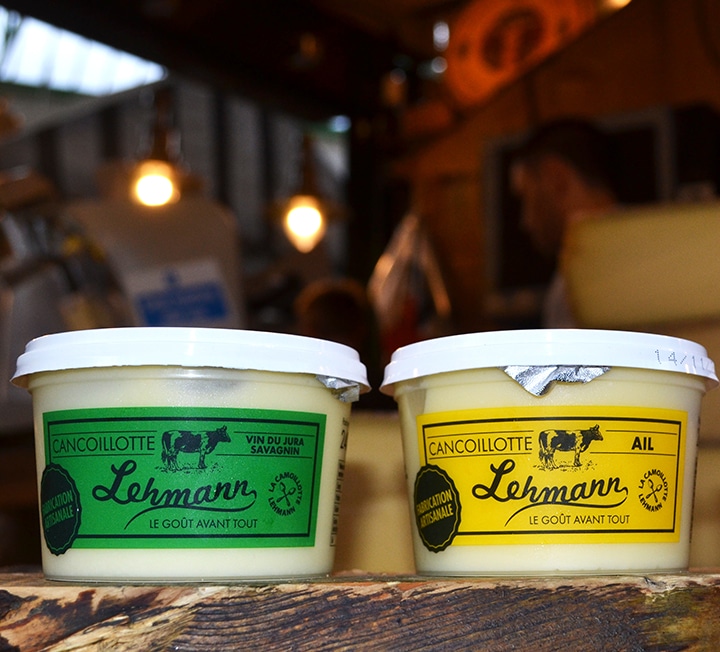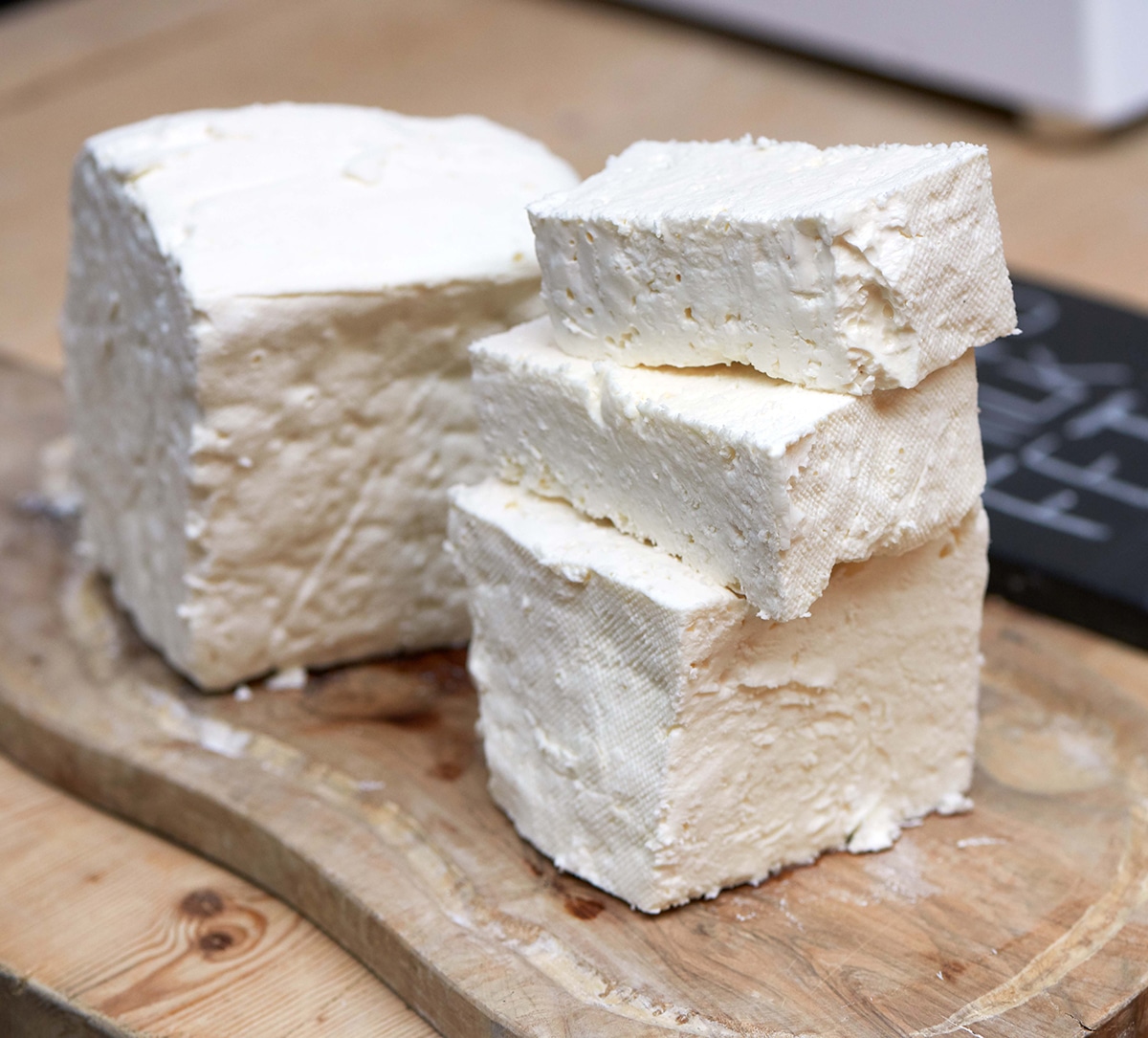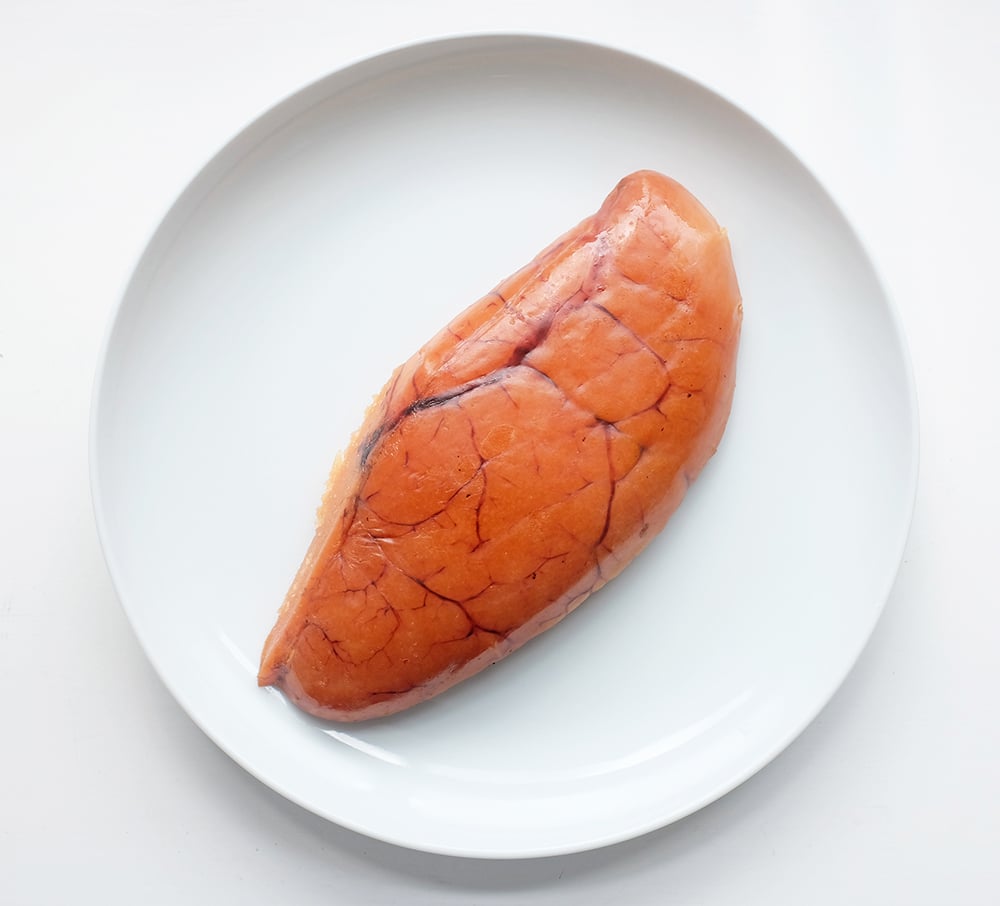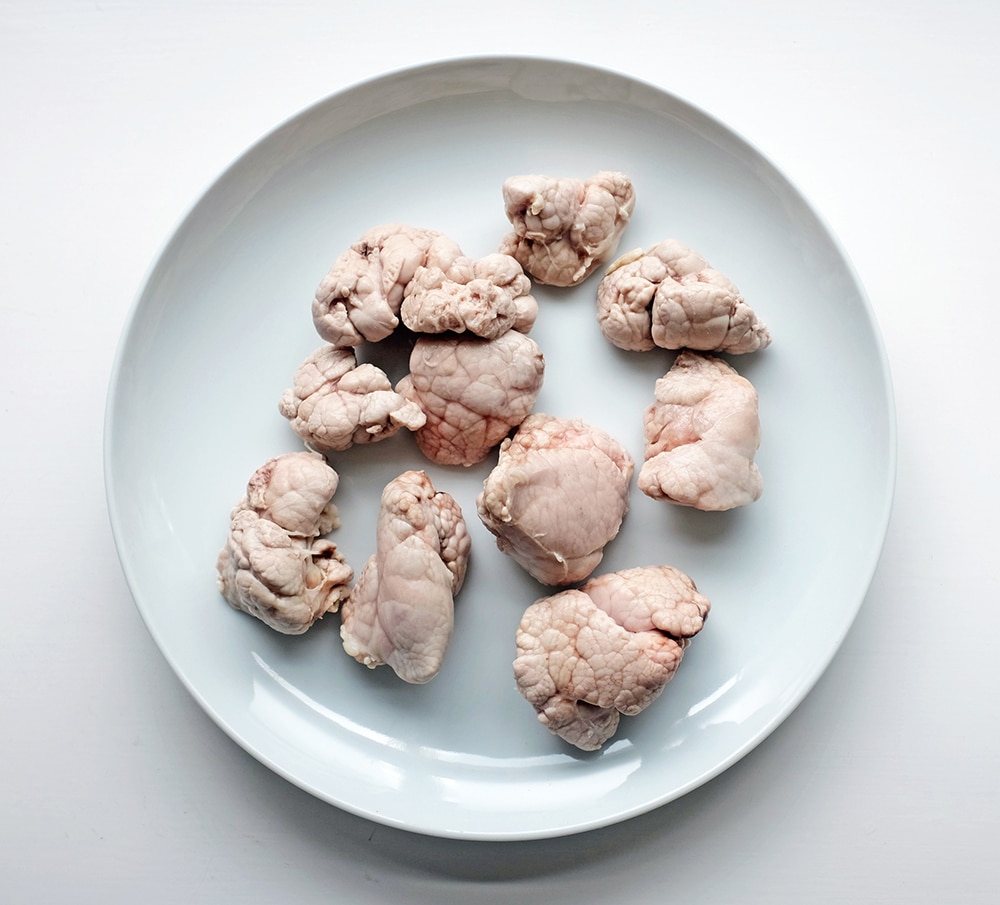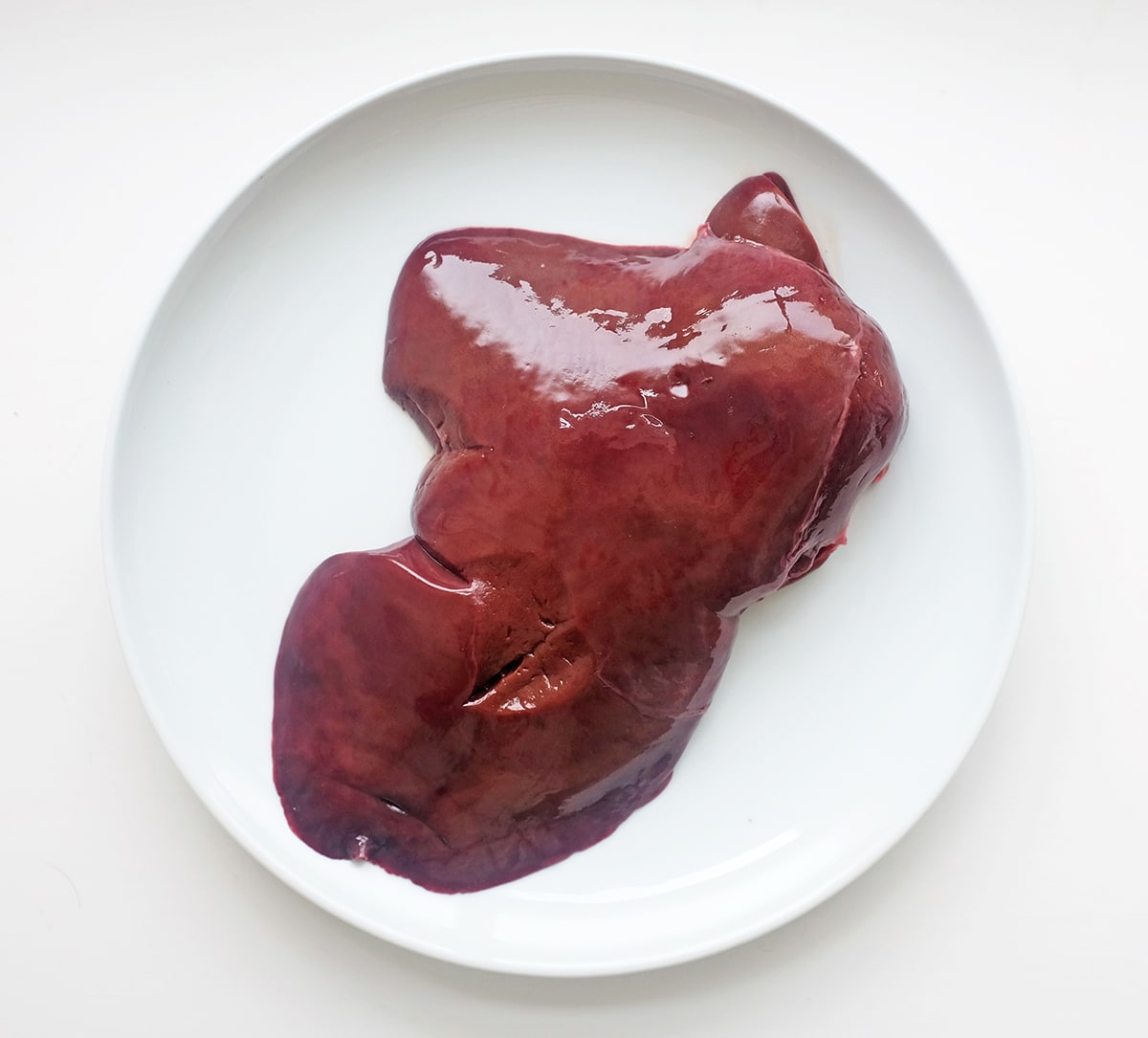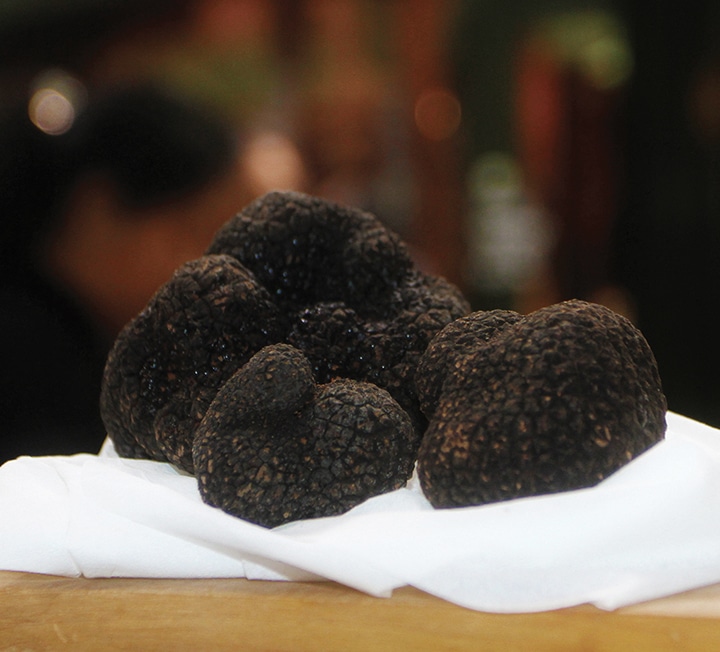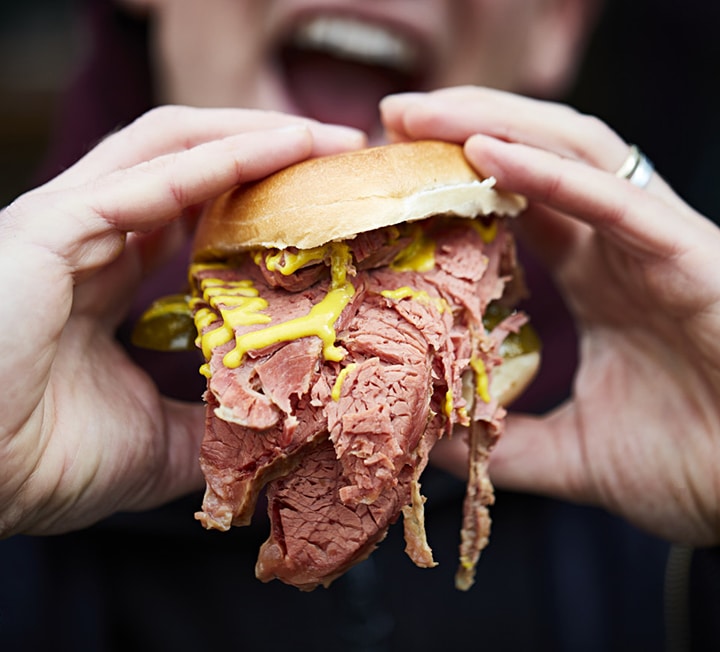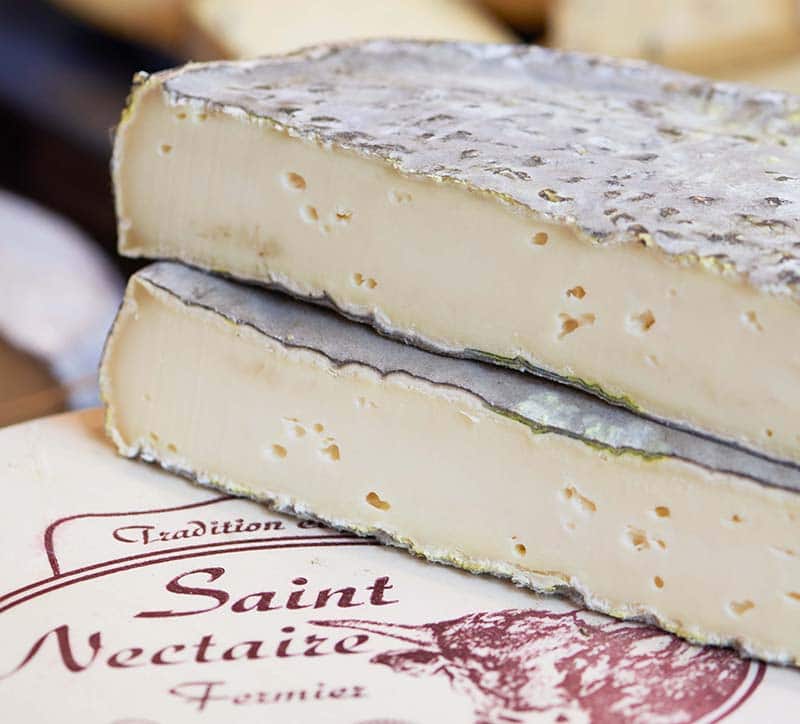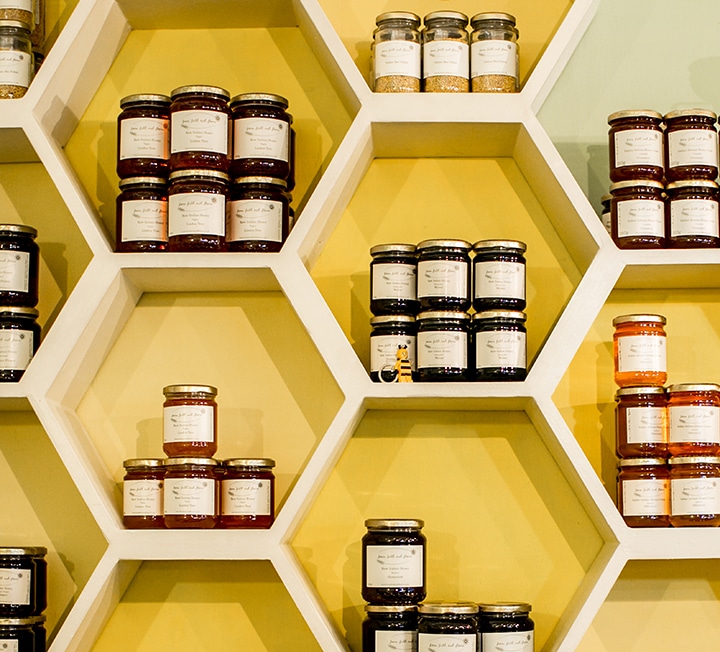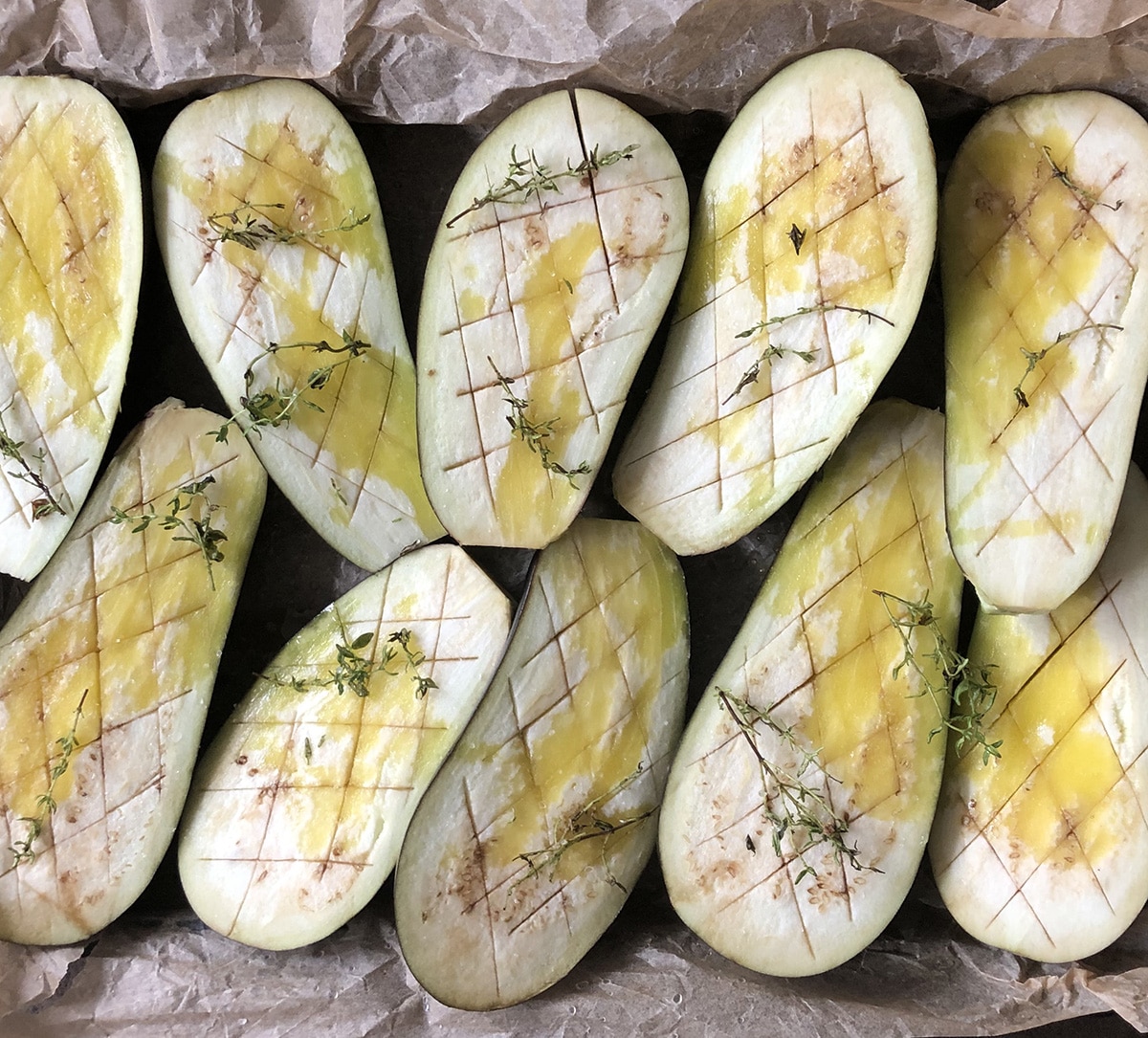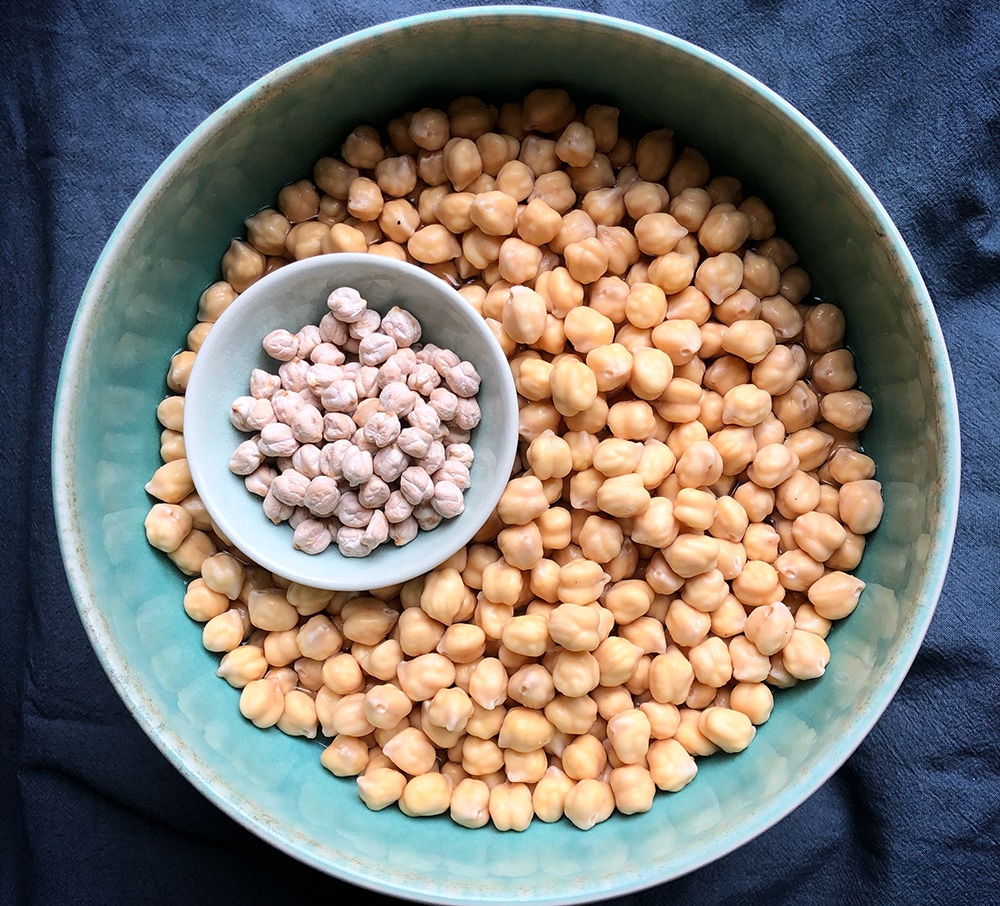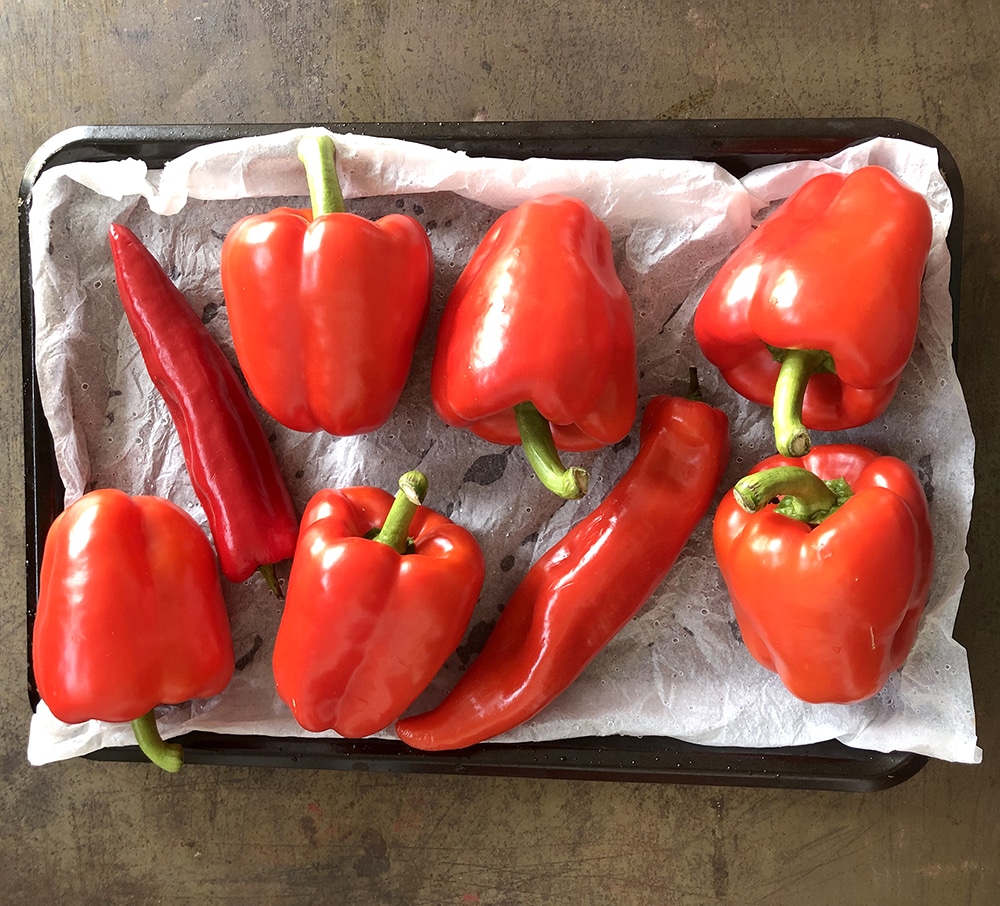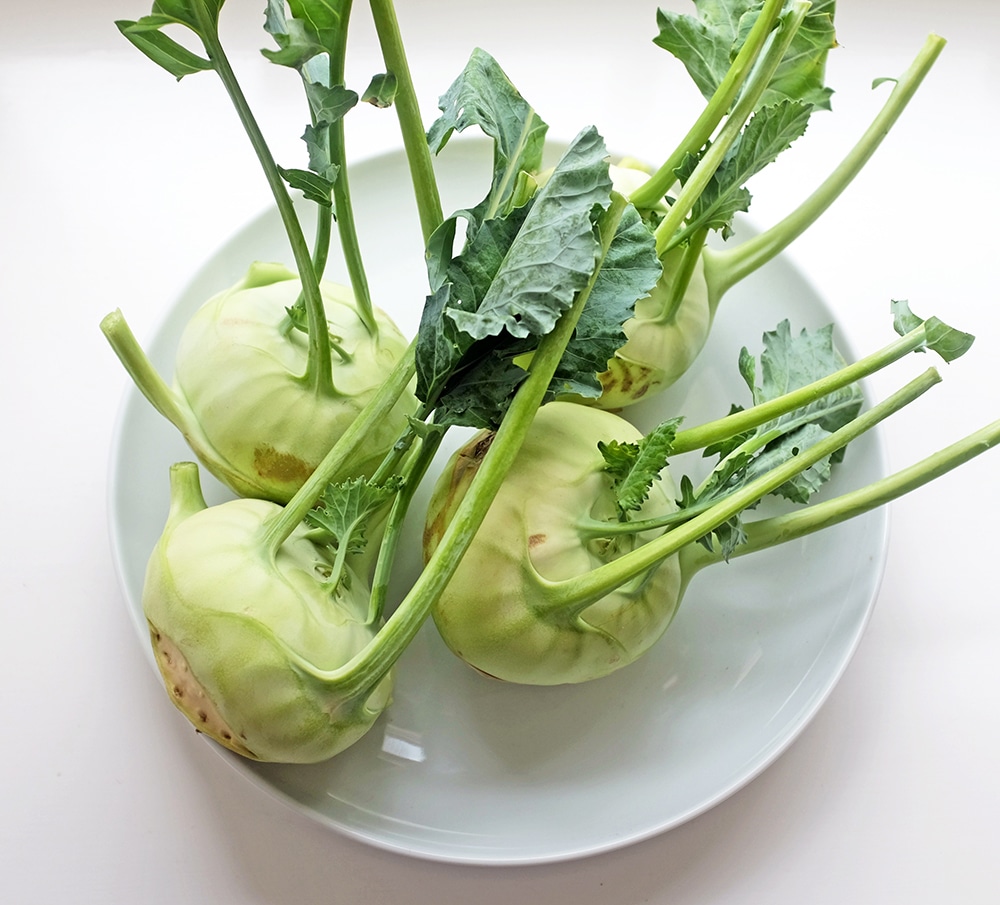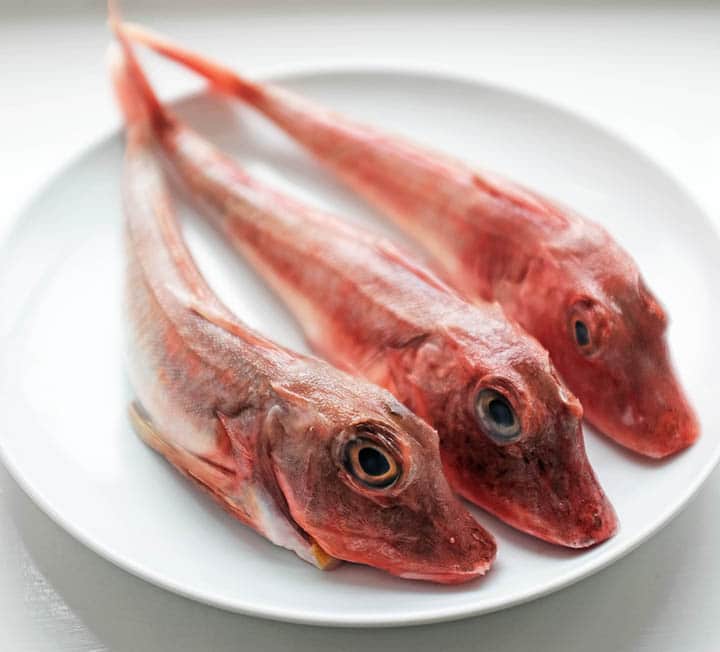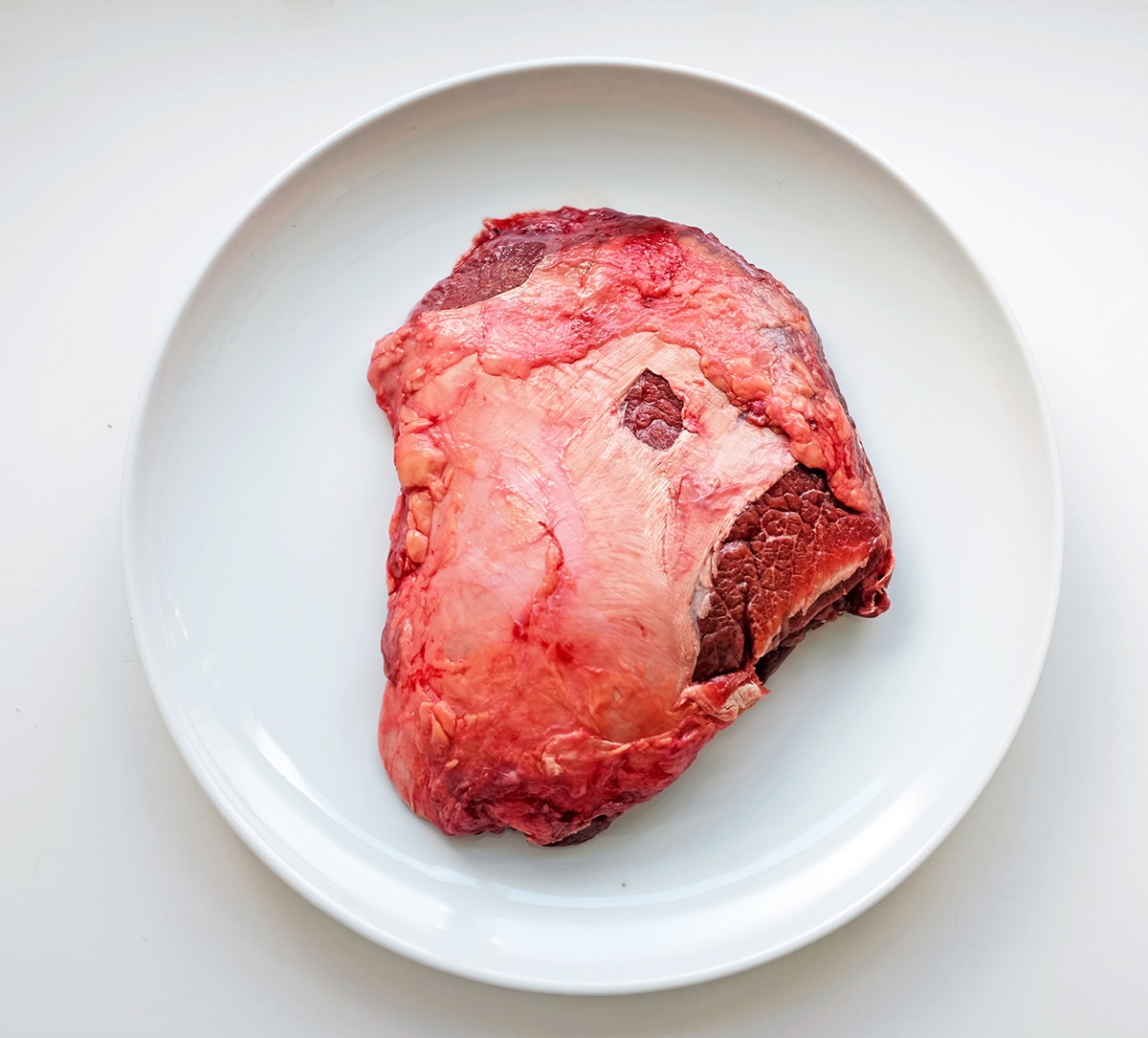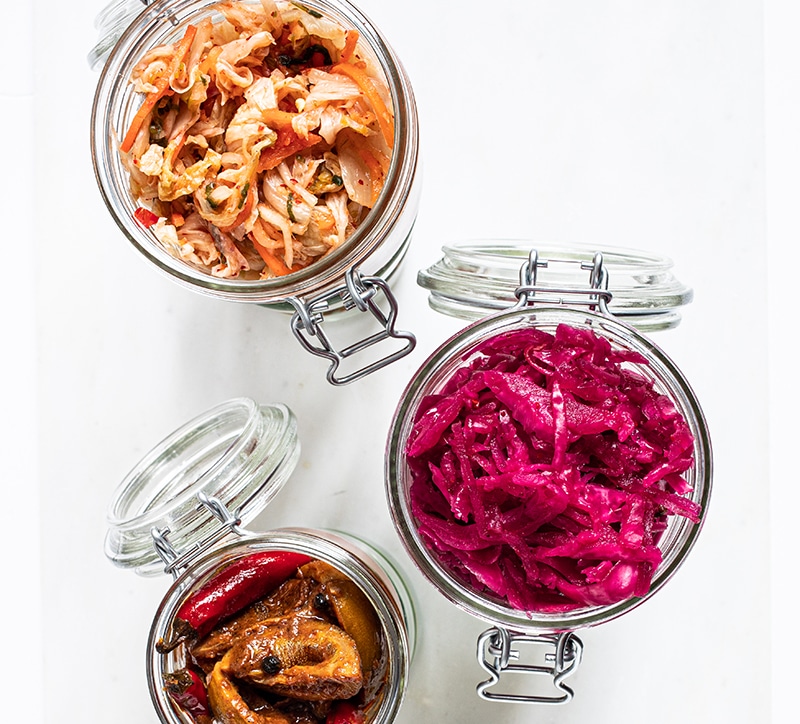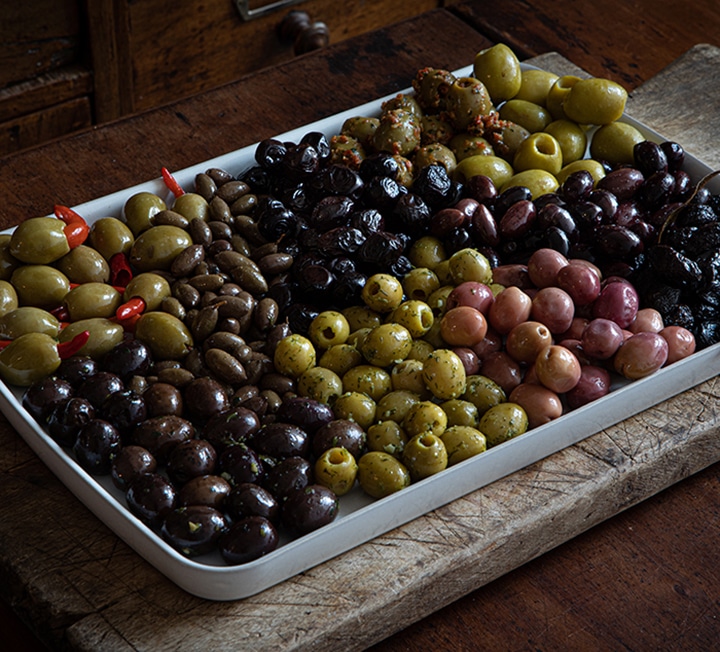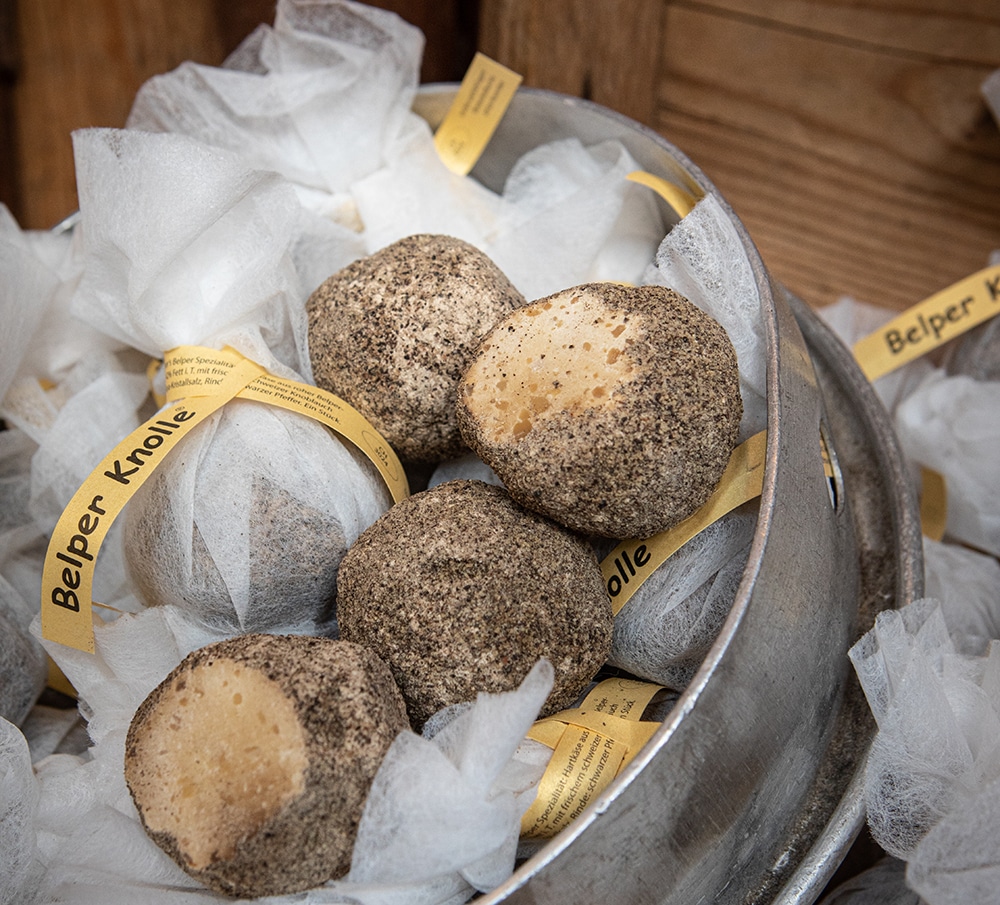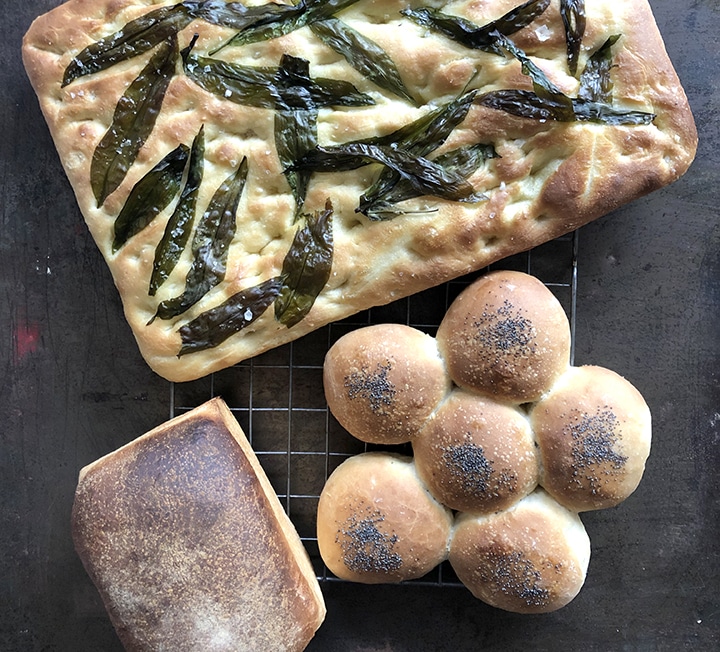The perfect Christmas dinner
Ed Smith sets out his vision for turkey and all the trimmings
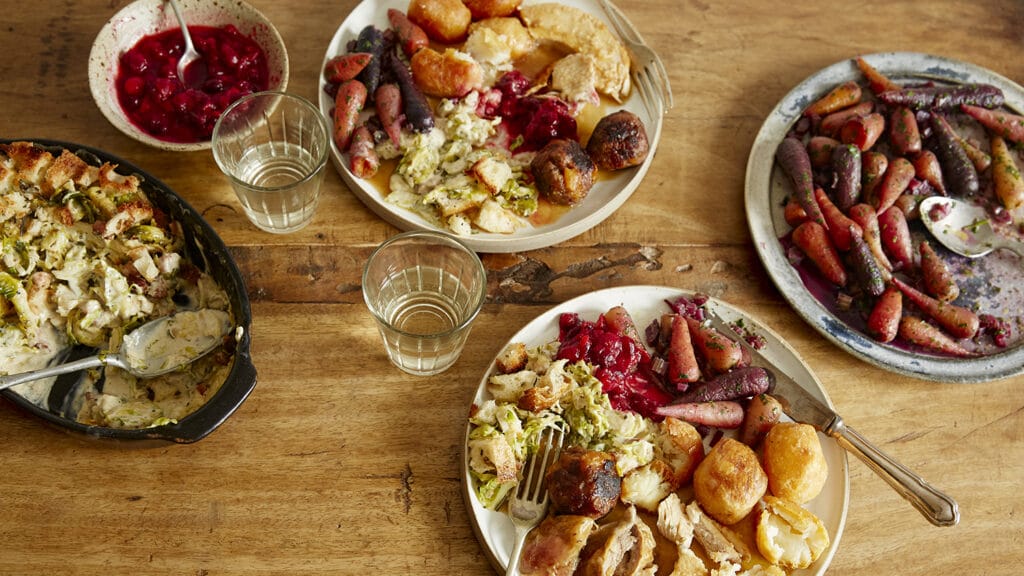

“YOUR MEAL WILL ALWAYS BE BEST OF YOU FOCUS ON HIGH-WELFARE ANIMALS AND SEASONAL FRUIT AND VEGETABLES”
The Christmas turkey has a strange reputation in the UK. For a significant proportion of households, turkey is The Thing to have as a centrepiece on The Big Day. And yet, so many of us claim to fear the cooking process and feel (at best) ambivalent about the eating experience. “Takes too long”, “it’s dry and tasteless” and “there’s no room or time for the best bits – the trimmings”: all are common complaints.
It doesn’t need to be this way. Your meal will always taste best if you focus on high-welfare animals and seasonal fruit and vegetables. You will enjoy both the cooking and eating of the turkey far more if you can buy a slow-grown heritage breed turkey, such as those you will find at Wyndham House Poultry, Ginger Pig and Northfield Farm. They are almost totally different animals to the intensively farmed Broad-breasted White (there’s much more to be read on how the modern industrialised turkey came to be in Mark Riddaway’s Borough Market: Edible Histories).
At the bottom of this pages, you’ll find links to my Christmas dinner recipes, but before we get to the practice, let’s deal with the theory. When it comes to creating the perfect Christmas dinner, I suggest you bear in mind these five points:
Thoughtful sourcing
Source a high-welfare, slow-grown heritage breed turkey.
Minimal stress
Don’t panic about cooking the bird, nor assume that it’ll take all day – just follow the instructions I’ve set out here.
Restraint with the sides
Plan only a couple of ‘star sides’, such as my carrot and sprout recipes, one of which is virtually hands-free, the other easily prepared in advance. Beyond them, keep things straightforward: cranberry sauce and bread sauce, stuffing balls, roast potatoes, gravy.
Well-prepared spuds
For the potatoes, the most important steps are: a) par-boil the potatoes a day earlier in salted water with some garlic and a few sprigs of rosemary, drain, rough-up, leave to cool, then refrigerate overnight; and b) when you roast them, do so in a shallow-sided tray in which the potatoes sit with plenty of space around them.
Plenty of rest
Rest the bird for at least an hour – it won’t be cold! – and cut the breasts from the carcass before slicing across them. Both steps are helpful for ensuring tender, succulent meat.
The perfect Christmas dinner
Ed Smith sets out his vision for turkey and all the trimmings


“I THINK FOOD HAS ALWAYS BEEN IMPORTANT TO ME, EVEN IF I DIDN’T NECESSARILY REALISE IT AT THE TIME”
Interview: Viel Richardson / Image: Christopher L Proctor
1. I have been trading here with Richard Bramble Collection for 20 years now – since the very beginning of the retail market. At the time, I was creating a series of paintings of Michelin starred chefs, which I published in a book along with their signature recipes. I was at Nico Ladenis’s restaurant Chez Nico when Fred Foster from Turnips came in, delivering vegetables. He liked my work and said that they were starting a market at Borough and he thought the customers would be interested in my food work. I’ve been here ever since.
2. I try to really capture the essence of an ingredient. I thoroughly research every subject. If I’m painting a fish, I use the knowledge I’ve gained from fishing and diving. Along with truly understanding how a fish moves, my skill in the graphic aspect is to capture the colours of, for example, an iridescent, silvery fish. I am trying to create something that is evocative of the spirit of that fish. At a food festival, one of my john dory dinner plates was once dive-bombed by a seagull. Quite a compliment. And the plate didn’t break!
3. Family holidays were spent in the Hebrides or Dorset, cooking what you foraged or caught. Looking back, this is where my passion for ingredients and cooking comes from. It also developed my fascination with our native wildlife.
4. When I started, you never saw a monkfish with a head on because they can be very dangerous when caught, so the heads were usually cut off straight away at sea. Les Salisbury from Furness Fish Markets brought in a complete one for me so I could paint it. Now you’ll often see them display a whole monkfish. It’s a great attraction!
5. I trained as a painter, so working with ceramics was not a planned path. It came about when a number of chefs asked me to create plate designs for their restaurants. I made a plate with an aubergine design for Gordon Ramsay’s first restaurant, Aubergine. That led to the start of my ingredients collection on ceramics.
6. The lines I have created and the way I have worked with the different pieces – the table mats, textiles and boards – often developed here on the stall, from talking to customers.
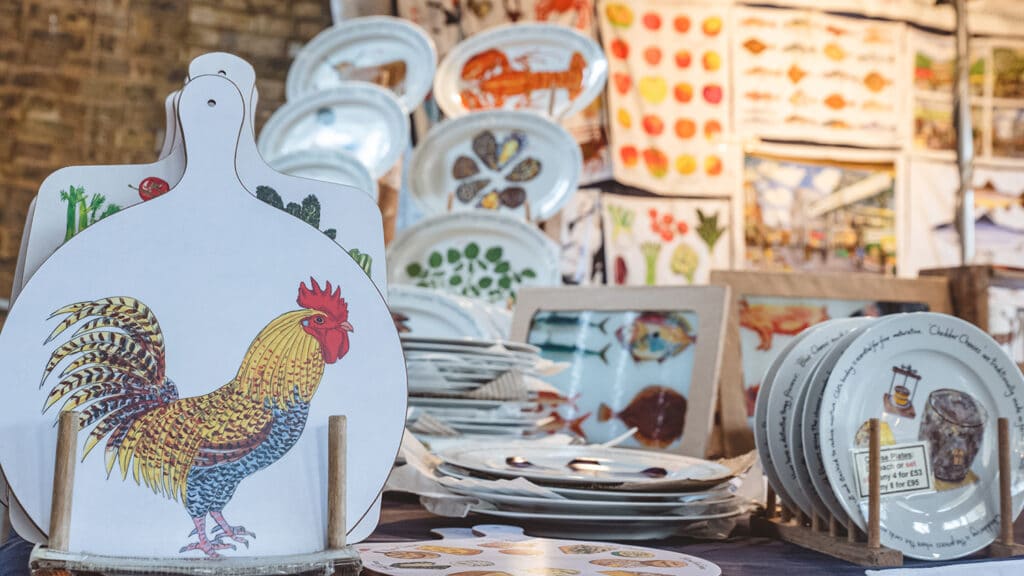
7. I have always painted and drawn. I think food has always been important to me too, even if I didn’t realise it at the time. I would go out fishing or gathering a few mushrooms. It was nothing fancy and it felt like a really natural thing to do. Looking back, I can see how that played into what I’m doing today.
8. Art and cooking are both creative processes; hand-eye coordination activities, underlined by feeling and knowledge. Combining the two worlds has been a natural process for me. When I see fresh and interesting ingredients sold by my fellow traders at the Market, it inspires me to paint them and experiment with them in my cooking.
9. Most of my work is done with pen and ink and watercolour. I then create a screen print from the originals using 12 or more colours, which is applied to the porcelain and fired into the glaze. Most ceramics are printed using only four colours; using 12 or more means the colours in the ceramics are often even closer to what I was trying to achieve than the originals.
10. The great thing about working with ceramics and textiles is that I’m creating affordable pieces of art for everyone; art that people use and interact with. I love the sense of community at the Market. I love talking to people about the piece they are buying, the significance, if it is for their kitchen or a gift. I can add an inscription to the piece while they wait – a name, a date, or a message – which makes the interaction even more unique. That connection is not something many artists get. A conversation with a customer or collector at the Market can be the highlight of my day.
The perfect Christmas dinner
Ed Smith sets out his vision for turkey and all the trimmings


“THE RACLETTE IS AGED FOR TWO TO THREE MONTHS BEFORE BEING EXPOSED TO COLD SMOKE FROM LOCALLY SOURCED WOOD”
To you and I and the majority of people reading this at their work desks or in a snatched break from the daily grind, the life of a Swiss cheesemaker sounds idyllic. Crisp mountain air, a deep silence punctuated only by the lowing of soft-eyed cows and jingle of bells; wild herbs on the breeze and the rich, unctuous aroma of maturing cheeses and sweet, fermenting milk. What’s not to like? Well, not much, acknowledges Marcello, the manager of Jumi Cheese’s Borough Market stall – but there is one small, universal challenge that even cheesemakers occasionally have to face.
Boredom. Yes, believe it or not, making cheese can be quite repetitive “and quite solitary,” Marcello continues. Now in his fifties, Herr Glauser – a cousin of Jumi founders Jürg Wyss and Mike Glauser – has been making cheese since he was 19 years old in the Swiss valleys where his family lives. But it’s his restlessness, manifested in experimentation with different recipes, that lies behind many of Jumi’s best products: Belper Knolle, Blue Brain and, now, a series of raclette recipes that transform this ancient staple of mountain cuisine.
Based on Glauser’s signature raclette recipe, but with the addition of a few weeks’ smoking, this is to our minds the most approachable of Jumi’s numerous unusual raclette varieties. As with all their cheeses, each litre of milk that makes up this semi-hard sensation comes from simmental cows: indigenous to the region, grazed only on fresh grass in summer and, come winter, homemade hay.
One of the reasons Jurg and Mike founded Jumi cheese in the first place was to support the small, family-run farms and dairies which were being undercut by industrial-scale producers. Every morning Herr Glauser receives a delivery of local milk which, being unpasteurised and unhomogenised, retains all the character of its locale and seasonality.
Once set and moulded into the square shape he favours (it is “more handy” for placing on the grill, Marcello explains) the raclette is aged for two to three months before being exposed to cold smoke from locally sourced wood. “It’s all about seizing the right moment,” Jurg and Mike have said, “which isn’t as easy as it may sound.”
Perhaps, on reflection, being a cheesemaker isn’t as easy as we might think. Perhaps we’re better leaving the making of cheese to those whose families have been doing this for generations, and stick to what we do best: buying raclette by the chunk, grilling and scraping it off onto bread, potatoes and gherkins, then savouring the salty, smoky, gooey, quintessentially Alpine taste.
The perfect Christmas dinner
Ed Smith sets out his vision for turkey and all the trimmings


“LOOKING AT A PIG’S HEAD,THERE DOESN’T SEEM TO BE MUCH YOU’D WANT TO EAT. AND YET THE BOUNTY IN A PIG’S HEAD IS WELL KNOWN”
It would be blinkered to say that the history of offal eating should be split BF and AF (Before Fergus and After Fergus), but it’s not that far from the truth.
The sensibilities of Fergus Henderson and his St John restaurant have had a huge impact on British (and indeed western) gastronomy, and the effect of his ‘nose to tail’ ethos is more obvious today than ever before. So many restaurants, chefs, writers and cooks espouse the importance of treating animals with respect and using every part of them that a chef coming out to say “we don’t bother with all that” would now seem extraordinary.
Of course, nose to tail encompasses all types of offal in all types of animals. But the subjects of this month’s post are, specifically, those bits at a pig’s extremities: the nose (and head), the tail and the trotters. What do they taste like, are they really worth eating, and if so, how should we cook them? Don’t they taste a bit dirty? And where’s the meat anyway?
Pigs’ heads
Looking at a pig’s head – or even your own – there doesn’t seem to be much that you’d want to eat. I mean, quite literally, why would you want to do that? And yet the bounty in a pig’s head is well known.
In particular, and least controversially, this treasure comes in the shape of cheeks and jowls. Cheeks are a powerful, constantly used muscle, so if you extract them there’s plenty to chow down on. It’s necessary to cook cheeks slowly – braised for a few hours – so that the collagen and sinew breaks down into beautiful, flavoursome gelatine. The jowls are good, too, particularly if cooked confit, and then fried – they’ve a quality that’s somewhere between fat and meat, and ultimately a bit like a grown-up pork scratching. Which is fine by me.
What else is there? Well, believe it or not, ears are good to chew on. Either braised or boiled first, then sliced and fried until crisp. Or, as the Chinese do, boiled, sliced finely, chilled and then marinated in spicy oils. It’s a textural thing.
Pig’s tongues are decent, so long as the outer membrane is peeled from them. Lots more thoughts on tongues will be presented in my next post, so we’ll leave it there for now, save to say that the tongue is also often included in pig head charcuterie – in brawn (more below), and also Bath chaps, the classic English ham made from rolling a jowl, cheek and tongue (if you pick the lucky side). The Ginger Pig sometimes sells jowl ham.
Speaking of charcuterie, it could be argued that some of the best things you can do with a pig’s head involve curing. There’s guanciale, of course: cured and air dried jowl, used by Italians in their pasta dishes. Coppa di testa is a ham made, like brawn, from the whole head. You might find some at the Parma Ham and Mozzarella Stand.
If you’re intrigued but think all of the above sounds like a bit of an effort (or a bit gross), one of the most rewarding things to do is to request a whole pig’s head, split in half, then braise this in the oven with a bit of wine. A few hours later and you’ve crisp crackling, succulent and tender flesh, and an amazing gravy. It’s more like a pork roast than a pig’s head at this point. See Henderson’s Nose to Tail Eating book for more.
Tails
“OK, I get there’s something to enjoy in a pig’s head. But surely there’s nothing to the tail?”
Amazingly, you’d be wrong to assume that’s the case. The funny, curly tails are surprisingly joyous to eat. Braise and the bread them (as with so many types of offal) and these crispy lengths are one of the better things you could nibble on. Again, Fergus Henderson should be the first port of call for a recipe. He suggests the longer the tail the better.
But there are other places to look – cooks from the American Deep South have enjoyed this part of the pig for ages, and many Caribbean recipes exist for split pea and pig tail soups. I can imagine the tails add a porky, savoury note, plus a natural gelatine to the soup.
Trotters
The Chinese and south-east Asians have long been better than us at making the most of a pig’s feet. Typical and very tasty options include red braised pig’s trotters (sugar, soy, Sichuan pepper, star anise), which are sticky and gelatinous and you need to be happy with gnawing around bones and cartilage, but I rather love it. Have a read of Fuchsia Dunlop for more on this.
Eastern cuisine is also well versed in using trotters in broths and stocks. Vietnamese pho is nothing without a trotter to add both its flavour and a certain, appealing viscosity (because of the collagen content).
Over here, Pierre Koffmann made trotters famous, with his much copied stuffed pig’s trotter – an absolutely classic dish at his restaurant La Tante Claire, later eulogised by Marco Pierre White and other Koffmann-trained chefs. The trotter is painstakingly deboned, then stuffed with a pork and morel mousse, before being served with the richest of gravy.
I’ve eaten the Koffmann version and it’s remarkable – if exceedingly rich. I also had to recreate it at catering college. Efficiently removing the bone while keeping the skin intact is one of the harder things I did. Koffmann takes just over a minute when doing a presentation. I hate to think how long it took me.
It seems appropriate to head back to St John to round things up. Trotters are celebrated there too, not least in a trotter pie – very little bite on the loose meat filling, but maximum flavour – and also the restaurant’s famed trotter ‘gear’. No gravy stands up to it, once you’ve tried.
Making brawn
Roasting or deep-frying a tail would’ve been the adventurous thing; and de-boning then stuffing a trotter the ultimate test of skill and patience. However, using the whole of a head (plus a trotter for luck) to make brawn, seemed the most appropriate way to approach this stage of the Offal Project.
Brawn is a set terrine comprising meat picked from a boiled pig’s head (and sometimes trotters too), held together by gelatinous stock made during the cooking process (the trotter helps achieve that quality). I really love it. It looks dramatic and is as tasty as any form of soft charcuterie you’ll come across; superb with some toasted sourdough and sharp pickles. It’s also incredibly cheap to make (expect to pay around a fiver for the head, £1 for some herbs and onions, and that’s about it).
That said, there are a few steps to go through when making it, so it’s a bit of an effort, if not actually hands-on laborious.
Pig’s heads are fairly easy to get hold of at the Market, but don’t expect to just happen upon them when walking past The Ginger Pig, Northfield Farm or Rhug Farm. Contacting one of those butchers in advance ought to guarantee success.
Admittedly, it’s quite an alarming thing to look down at a pig’s head that’s looking back at you. Particularly if you’ve a mild hangover. You do need to look at it though, not least because it’s necessary to give it a good wash, shave it, and clean wax and grime out of the ears. After that, find a pot that’s large enough to simmer the whole thing (we’re talking 8-10 litre volume, if not more), leave it to bubble for 3-4 hours, pick the meat from the trotter and head, mix in some chopped tarragon and leave to cool in a terrine overnight, using the gelatinous stock as a setting agent.
As mentioned, glorious on toast with pickles, and a bit of a talking point. You could dip cubes of it in flour, egg and breadcrumbs too, then deep fry, for dreamy (or, for some, nightmarish?) pig’s head nuggets.
The perfect Christmas dinner
Ed Smith sets out his vision for turkey and all the trimmings


“SOMEONE WHO WORKED HERE A CENTURY AGO WOULD STILL RECOGNISE THE ARBROATH SMOKIES WE PRODUCE TODAY”
Interview: Viel Richardson
One of the defining products of your Oak & Smoke stall is the Arbroath smokie. What exactly is it?
A type of hot smoked haddock. Arbroath smokies have EU protected status, meaning that only haddock smoked using traditional methods within a five-mile radius of Arbroath can use the name.
Where did the process originate from?
It all started in Auchmithie, a small fishing village a few miles north of Arbroath, whose population had originally settled there from Scandinavia. The women would salt the fish then smoke them in barrels with fires at the bottom, while trapping the smoke under layers of hessian sacking. In the early 1900s, some of the community began moving to Arbroath and the fish they produced became known as the Arbroath smokie. In the days before refrigeration, this was an important method of preservation. Salting removed a lot of the moisture where the bacteria gathered, and smoking killed the bacteria that were still present. The combination of the two processes allowed the fish to be stored for longer.
Walk us through the process.
The fish are covered in salt, then pairs of them are tied together by the tail and hung up for about 24 hours. To smoke them, these pairs of fish are draped over metal rods that have been laid across the open top of a whisky barrel that’s had its top section cut off, with a fire burning inside.
The fires are built using a combination of beech and oak wood. The fire burns initially for between 60 and 90 minutes, with a wet hemp cloth draped over the whisky barrel. Wetting it stops the hemp from catching alight and traps most of the heat, creating a very hot, moist environment. Once the required temperature has been reached, the wet hemp is removed, the metal rods with the tied fish hanging over them are placed over the top of the barrel, then the cloth is draped back over them. The hanging fish are very close to the heat source, so they are being smoked at a very high temperature. Quite often, in fact, some of the fish will be licked by the flames of the fire. The high heat slightly crisps the outside while the high humidity keeps the flesh moist. This is what gives the smokie that wonderful, almost creamy texture and deep smoky flavour that you cannot find anywhere else.
Do you use whisky barrels for all your smoking?
No, we also smoke in a traditional smokehouse, which is designed to recreate the environment of the barrel, producing that hot, damp environment. It means that you can smoke more fish each time, although still a lot less than the huge commercial smokeries. Which method we use will depend on how many fish we need to smoke, but both the smokehouse and the barrels are in use.
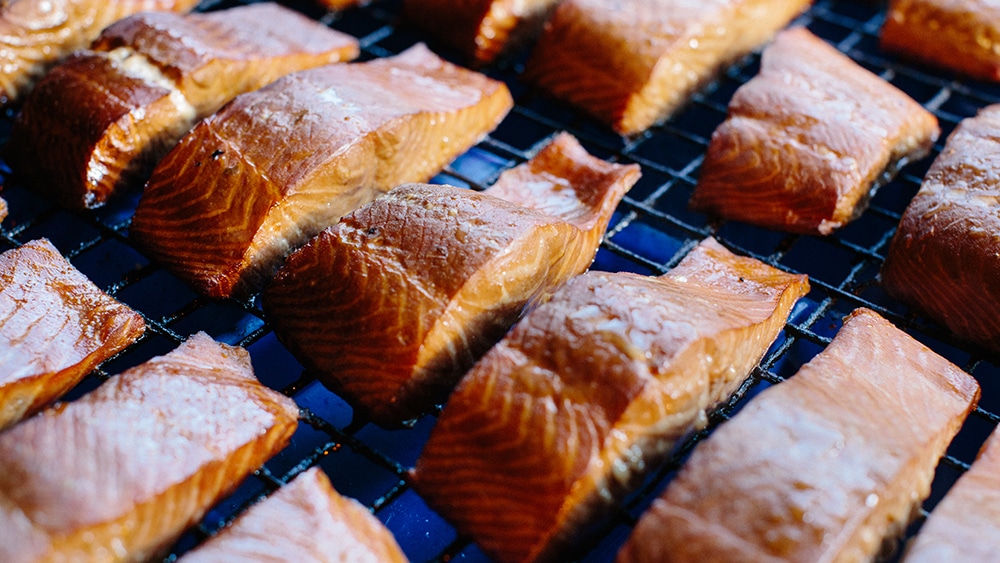
Does the type of barrel used have an effect?
Not really, if the barrel imparts any flavour, it is negligible. Most of the flavour is coming from the wood used to create the fire and the tar around the sides of the barrels and the smokehouse. Our smokehouse is over 100 years old and there are several inches of accumulated tar from decades of smoking fish.
How is this different from other commercial hot smoking methods?
For almost all the hot smoked fish you buy from supermarkets, the producers will use smoking ovens. In these, 90 per cent of the heat source is typically from electricity. They will then put in some wood kindling at the bottom of the oven to smoulder and impart some smoke flavour to the fish. This is different from the traditional way, with that hot, intense smoke really impregnating the fish. Electric smoking ovens cannot recreate the environment of a whisky barrel or smokehouse.
Do you smoke other fish?
Because the smokies were so popular, we started smoking other fish in the smokehouse and found that oily fish tended to work best. We do hot smoked salmon, trout and mackerel. We also cold smoke salmon.
How does that differ from hot smoking?
The crucial differences are the temperature of the smoke and the fact that the fish is kept away from the heat source. Despite the name, the smoke does not have to be cold, just a lot cooler than that used for hot smoking.
Do you use a different smokehouse for the cold fish?
No, we don’t. We use the same smokehouse with the beech and oak fire as we do for the smokies. We will generally do the cold smoking once the smokies have finished and been removed. The smoke is sent along what is essentially a horizontal chimney, designed to cool it down as it goes. The smoke then fills a second chamber where the salmon is laid out on trays. Because of the absence of heat, cold smoking takes a lot longer – somewhere between 12 and 24 hours, depending on how much salmon is in the chamber.
Do you use any preservatives?
No chemicals of any kind are used. The only preservatives are salt and smoke. We get all our fish fresh – the haddock for the smokies has to be caught in the north Atlantic. They are then salted before going straight into the barrels or the smokehouse. Our fish is not frozen at any point.
So, your production methods are just a continuation of a very traditional process?
Very little has changed, because very little needs to. Over the generations, smokers have continued honing their skills, but someone who worked here a century ago would recognise the Arbroath smokies we produce today.
The perfect Christmas dinner
Ed Smith sets out his vision for turkey and all the trimmings


“IT WAS LIKE WANDERING INTO THE CAVERN CLUB IN 1962 AND THINKING THAT THE LOCAL BAND SOUNDED PRETTY GOOD”
Image: Orlando Gili
The best eating experience of my life (and, therefore, possibly the best experience, full stop) arose through a golden combination of chutzpah, libido and luck. As a young man whose lack of breeding and meagre knowledge of food were offset by a bloody-minded will to impress a young woman, I decided that what she and I absolutely needed to do was eat at a properly posh restaurant, just to see what it was like. After interrogating a guidebook, I picked out a place called La Tante Claire and booked a table. What I didn’t know was that Pierre Koffmann’s place, then at its 1990s peak, was not just a posh restaurant but an era-defining one, and that our guileless joy at eating there was akin to wandering into The Cavern Club in 1962 and thinking that the local band sounded pretty good.
The whole evening was completely mind-blowing, only slightly tainted when, as I passed through the bar, a jowly man demanded I tell him where the toilets were, his brusque approach revealing that, stuffed into a cheap suit, I looked not like the urbane epicurean of my imagination but a junior staff member, possibly a cloakroom attendant. The most memorable thing presented to me all night (apart from the bill, which I cleared from my credit card about five years later) was a plate of scallops with squid ink, a Koffmann signature, which I thought sounded like the starter a person who knew about these things would go for, even though I’d never eaten a scallop and had no idea that squid ink was food. Simple but achingly pretty, firm but yielding, sweet but deeply savoury, it immediately superseded a chicken tikka roll from Tooting Bec as my favourite dish of all time.
It was also probably my first real glimpse of how a plate of food can transcend its apparent simplicity when exceptional produce is involved. I may still look more like a cloakroom attendant than a sophisticated gastronome, and I will never be able to cook like Pierre Koffmann, but what I – and anyone else – can do is pick up some scallops from Shellseekers Fish & Game, hand-dived just a day or two earlier from a Devon bay, then fry them with slightly terrified care. And by using raw materials at least as good as anything the Frenchman had to work with, I can, right there in my kitchen, do justice to some tiny fraction of that special memory.
The perfect Christmas dinner
Ed Smith sets out his vision for turkey and all the trimmings


“YOU MAY AS WELL ROAST A DOZEN BEETROOTS AND BE WELL ON THE WAY TO PREPARING TWO OR THREE DISHES IN ONE GO”
Autumn really is the time to eat British beetroot, newly harvested and gloriously sweet. The roots love other seasonal treats such as apples and nuts and their fabulous deep pinks and yellows add pizazz to any plate.
Beetroot can be eaten raw: grated in a winter slaw, sliced paper-thin for crunchy carpaccio or whizzed into a smoothie – just remember to add plenty of citrus or vinegar to counterbalance its intensely earthy flavour. Boiling beets is an option too but never does, in my mind, deliver the same depth of sweetness as roasting, low and slow, to bring out their magical flavour.
This is where the batch cooking comes in: there’s really no point in firing up the oven for a good hour to cook a few mouthfuls, you may just as well roast a dozen beetroots and be well on the way to preparing two or three dishes in one go.
I usually opt for beets no bigger than a tennis ball, so there’s no chance of woodiness – their size means quicker cooking too, as I like to leave them whole (retaining their intense colour and keeping a pleasing shape if I end up slicing). Give the roots a good wash to remove any soil but don’t peel, the skins will slip off easily enough once roasted. Preheat the oven to about 170C (don’t be tempted to up the heat) and place the beetroot in a roasting tin with a few tbsp water, cover tightly with foil and cook for anything between 45 mind for baby beets and well over 1 hour for larger roots. Once a knife glides easily through the flesh, you’re done.
Leave to cool under the foil and then you can slide off the skins with your fingers, or scrape with the back of a knife, but do remember to keep the more traditional deep-pink beets separately from any golden or chioggia varieties, as they will bleed. Oh, and a word on those amazing candy-striped chioggia – they lose their stripes as they cook, so I tend to keep them for raw salads.
How to use your roasted beetroot
— Blitz to a purée with chickpeas, tahini, olive oil, garlic, roasted cumin and lemon juice for a Barbie-shaded hummus or with walnuts, cream cheese, a splash of cider vinegar and then chopped dill to finish.
— Make a soup: fry onions with garlic and fresh ginger, add cubed potato and stock (chicken or veg). Once the potato is soft whizz the mixture with roasted beetroot, orange juice and orange zest.
— Stir cubed beetroot into hot mains: risotto works beautifully if you add chopped beetroot once the rice is almost ready, along with thyme and pecorino. Or, cook split peas or lentils into a dal with ginger, garlic and turmeric and then add chopped beetroot, coconut milk, mustard seeds, curry leaves, chilli and lime juice.
— Create a salad: go north with smoked mackerel, dill, apple, potato, walnuts, wine vinegar and crème fraîche; go Italian with salsa verde ( parsley, anchovy, mustard, capers, vinegar, olive oil) and cannellini beans; or go south with this spiced beetroot salad.
Hidden charms: medjool dates
Determined that you should never judge a book by its cover, Ed Smith explores the hidden charms of some of the Market’s less obviously alluring ingredients. This time: medjool dates
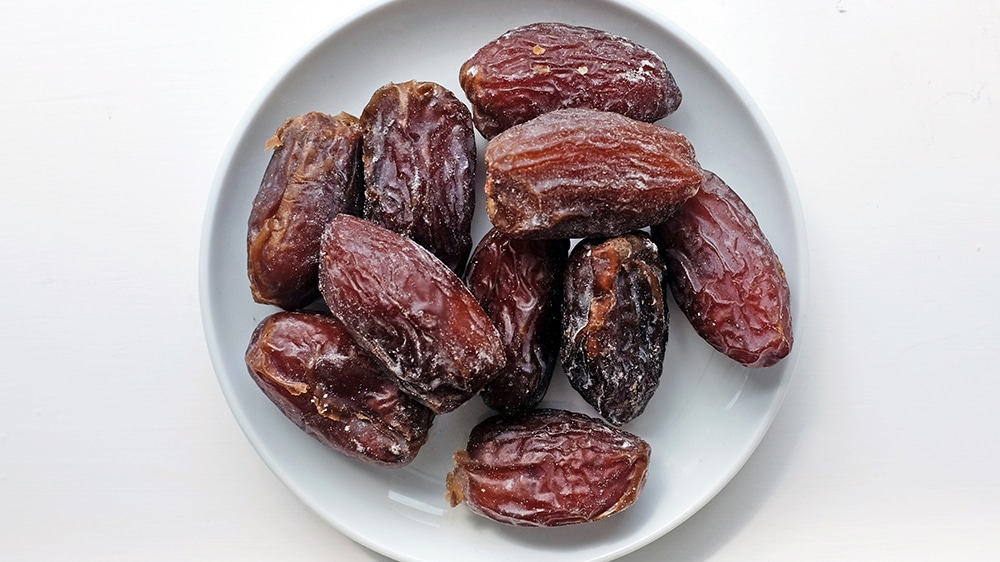

“THE STARTING POINT FOR A BRIT IS STICKY TOFFEE PUDDING. THE KING OF PUDDINGS IS NOTHING WITHOUT THE KING OF DATES”
Of course, it’s tricky to think dispassionately once you’re aware of the sweet, sticky joy of a medjool date. But let’s be honest: objectively, dates are ugly little things aren’t they?
Brown is not a colour that draws attention or joy, and the fact they’re ribbed and shrivelled suggests, at best, a shy disposition. Compare the piles of dates at Turnips with the many exotic fruits peacocking nearby; the dates literally shrink into the shadows.
How can the humble date compete with the likes of the arrogantly plumed pineapple, funky star fruit, smooth, suggestive granadilla or just plain weird rambutan? In truth, those other fruits have nothing on the taste or versatility of the medjool date.
The ‘king of dates’ has been harvested in the Middle East and north Africa for thousands of years – its caramel-cinnamon flavour and melt-in-mouth texture providing a golden and luxurious finish for any meal. These are the fruits of the date palm, a tree that with modern irrigation can yield over 100kg of fruit two or three times a year. Its high sugar content means it’s as adept for modern export around the world as it was at lasting for a long time in an ancient Egyptian larder.
I suspect that the world is divided into two types of people: those who can’t resist taking and eating a medjool date as soon as they spy a batch, and those who couldn’t care less… because they’ve never tried them.
Well, the first stage of conversion is to do just that – pick one up and eat it exactly as nature intended. A medjool date is a natural, ready-made sweet that’ll knock the socks off any man-made toffee or candy you can buy. The next stage is to use dates in your cooking, making the most of their undoubted quality (if not their look). The obvious starting point for a Brit is sticky toffee pudding. The king of puddings is nothing without the king of dates.
More recently, medjool dates have become the go-to refined sugar replacement for the ‘wellness’ generation – granola bars, ‘raw’ brownies and the like now rely on their sticky sweet powers. However, I’d argue (perhaps counterintuitively) that medjool dates really come into their own in savoury dishes. Tagines and lentil stews benefit from both the sweetness and the chew of a date – it lifts rich meats or savoury pulses, bringing sweetness and interest to the dish. Lamb, in particular, is a fan of the date.
Imagine, say, a platter of slow roast shoulder sprinkled with chopped dates, fresh mint, feta and pistachios. You’ll find dates work well with roasted roots, too – things like carrots and parsnips, particularly if they’ve been laced with sweet spices like cardamom, ginger or cinnamon.
I enjoy pairing dates with roast cauliflower. The brassica takes on an amazing earthy nuttiness when roasted, and it seems to love the punctuation that little chunks of chewy dates provide, similar to the effect of raisins.
In the recipe that accompanies this article, the cauliflower florets and dates are dressed with plenty of lemon juice and cold pressed rapeseed oil. There’s a tahini dressing option, but to be honest it doesn’t really need it; not least because it detracts attention from those dates.
See Ed’s recipe for fresh date & roast cauliflower salad.
The perfect Christmas dinner
Ed Smith sets out his vision for turkey and all the trimmings


“THESE POWDERS ARE SUCH A BRILLIANTLY EFFECTIVE WAY OF ADDING LIP-TINGLING LAYERS OF FLAVOUR”
Image: Regula Ysewijn
Over the past two decades or so, British home cooks have been educated in the art/joy/craft of adding fresh herbs to a dish. It’s one of Jamie’s greatest gifts to us, I guess: the idea that fresh basil, mint, coriander, parsley or dill should be measured in fists, not pinches. He (and others no doubt) have freed us to add herbs as we might if we were in Tel Aviv, Tbilisi, Tehran or Hanoi: by the literal bunch.
That liberal scattering of fresh herbs might even be second nature now (as an aside, it’s easier to do when you buy vibrant yet delicate green leaves from a market greengrocer, rather than the little plastic packs in a supermarket). But I wonder whether our current enjoyment and appreciation of them means we forget that there’s also much to be said for seasoning and embellishing with dried herbs and spices. A heaped teaspoon or more of a spice mix at the end rather than mid-way through the cooking process can really ‘make’ a dish, too.
Cruise the shelves at Arabica and Spice Mountain, and in amongst the tempting pots and pouches are tubs of sumac, za’atar and dukkah. These spices and blends are increasingly part of our everyday larders; maybe not yet in the same way as you might find in the Middle East (where there are often pinch pots on tables in the same way we leave salt and pepper) but many of us will have them in a cupboard somewhere. There’s a chance they’re two-thirds full and fading in their potency. In which case, use them more often and in greater quantity!
The sharp citrus tang of sumac, the zingy fragrance of the dried oregano in a good za’atar, and the nutty crunch of dukkah: these powders are such a brilliantly effective way of adding lip-tingling layers of flavour to grains, leaves, grilled meats and roast vegetables. Yes, they’re dusty, which might seem off-putting at first, but, as with fresh herbs, it pays to add about twice as much as you think you need. Counterintuitively, the more it looks like you’ve dropped your great-uncle’s urn on, say, a platter of golden-crisp chicken thighs, the more alive they will be.
Spice Mountain’s blends go beyond the Middle East. I’m a fan, in particular, of the stall’s Japanese seasonings. One, gomashio, is technically just a mix of sesame seeds and salt. But it’s somehow far more than the sum of its parts, particularly good as a dusting for roast vegetables or steamed fish. Another, which you should acquaint yourself with if not already familiar, is shichimi togarashi: a blend of seven spices that majors on chilli powder, but also dried citrus and nori (seaweed). There’s heat, sourness, umami from the seaweed, a real shot in the arm for any rice-based dish or soup. Consider a scattering of ume plum sesame seeds too, which I noticed last time I was at the stall and haven’t yet tried, but suspect are a more-ish combination of sour and savoury.
There’s more: like tabil, a Tunisian and Algerian mixture consisting of coriander, garlic and caraway, and often the likes of mint, cloves and turmeric. We’re so used to putting these types of spices in among the onions as they soften, or perhaps in a stew while it bubbles down. But a last minute dusting over something like a lamb chop or even stirred through roast potatoes (or any fried potato) would be effective. Ditto a chimichurri blend of parsley, oregano, red pepper flakes, and garlic – something you could sprinkle on a steak or flatbread, but like za’atar is even more effective mixed with olive oil and drizzled.
Much can be done with all of these blends. On the one hand, it’s worth looking to their use in the countries they originate from. But I think we can use them more casually, too – if ever a mid-week meal or weekend egg feels bland, could it be transformed by a few spoonsful of dukkah or an explosion of shichimi togarashi? Probably. So next time you finish plating up and bemoan the fact you’ve forgot to add fresh herbs to your shopping basket, pause and consider whether there’s actually something dry and dusty in your spice cupboard that could be just as enlivening. Dust away.
The perfect Christmas dinner
Ed Smith sets out his vision for turkey and all the trimmings


“AUBERGINE MUST BE COOKED UNTIL IT BREAKS DOWN INTO A SILKY, ALMOST SLIPPERY TEXTURE – AND THEN IT’S HEAVEN”
Standing over a hot stove in the sweltering summer heat is surely nobody’s idea of fun, so roasting a tray of aubergines, with all the quick and delicious options they offer, makes perfect sense.
As a child I loathed the cardboardy, almost squeaky, chunks of aubergine that mum used to serve up in the ratatouille. Undercooked aubergine really is appalling. Still today you get the odd chunk of rather watery, chewy flesh in a pasta sauce or badly cooked moussaka. There really is no excuse – aubergine must be cooked until it breaks down into a silky, almost slippery texture and then it’s heaven.
There are dozens of aubergine varieties, their lustrous skin can be anything from ivory to green; magenta-striped to a deep, purply-black. They vary in shape and size from the tiny green pea and slender finger aubergines of southeast Asia, to the egg-shaped (hence their other name, eggplant) so popular in India and then to the larger more ubiquitous types we tend to find in Europe. My batch roasting requires the latter and the only golden rule that applies to each and every aubergine is that it should look shiny and tight in its skin and feel firm, otherwise it’s past its best.
Salting aubergines before cooking draws out any bitter juices and also collapses the structure of the sponge-like flesh so that it absorbs less oil. I’ll admit it now, I’m far too impatient a cook to bother and nowadays the hybrid strains on offer have next to no bitterness at all. Roasting rather than frying allows you to control the amount of oil you use in any case, but don’t be too stingy – aubergines and oil, particularly olive oil, are the best of friends.
I tend to cook aubergines by the half dozen in a hot oven at about 200C. Just slice the aubergines in half lengthways and then crosshatch the flesh with a sharp knife, leaving the skin intact. Drizzle with plenty of extra virgin olive oil and sprinkle with a little salt. Herbs are up to you: I often throw over a few sprigs of thyme or push thin slices of garlic down into the cuts but hold back on the spicing so that you can take the cooked aubergines in any number directions.
Roast the aubergines for 30-45 mins, until they have browned at the edges and become really soft and squashy – no squeaky cardboard, thank you. What happens next is your call: straight from the oven with a squeeze of lemon and a pinch of chilli is pretty unbeatable. Then you can use the rest of the tray over the next three or four days.
How to use your roasted aubergines
Reheat the aubergine halves for 10 mins in a hot oven, topped with:
— A few slices of tomato, garlic, mozzarella and a sprinkling of grated parmesan.
— A mixture of breadcrumbs, capers, anchovies, green olives, lemon zest, lemon juice and extra virgin olive oil.
— Miso, tamari, maple syrup, mirin, sake (or dry sherry) and a tiny splash of sesame oil shaken together in a jar. Check the balance and then pour over the aubergine. Top with toasted sesame seeds and spring onions.
Scrape out the flesh of the aubergine and re-stuff the skins with:
— A fried onion and Italian sausage mixture, plenty of herbs, sultanas, the aubergine flesh.
— Cooked rice, fried onion, sun dried tomatoes, the aubergine flesh and even a little leftover ragú or cooked lamb mince.
Chop up into cubes, skin and all, and fry with:
— Diced onions, garlic, courgette, red peppers, tomatoes and basil for a ratatouille of sorts ( the pre-cooking of the aubergine will guarantee a perfect texture).
— Diced onion, garlic, celery, tomatoes, capers, green olives, sugar and white wine vinegar for a Sicilian, sweet and sour caponata.
— Diced shallot, tomato purée, garlic, cumin, fresh coriander, chilli and lemon juice for a Moroccan zaalook.
Spoon out the flesh and blitz to a purée with:
— Tahini, smoked paprika, lemon juice and seasoning for a quick baba ghanoush.
— Yoghurt, cooked lentils, toasted cumin, garlic and pomegranate molasses.
See Jenny’s recipe for roasted aubergine with feta & freekeh salad.
